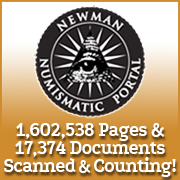
About UsThe Numismatic Bibliomania Society is a non-profit organization devoted to the study and enjoyment of numismatic literature. For more information please see our web site at coinbooks.org SubscriptionsThose wishing to become new E-Sylum subscribers (or wishing to Unsubscribe) can go to the following web page link MembershipThere is a membership application available on the web site Membership Application To join, print the application and return it with your check to the address printed on the application. Print/Digital membership is $40 to addresses in the U.S., and $60 elsewhere. A digital-only membership is available for $25. For those without web access, write to: Terry White, Treasurer AsylumFor Asylum mailing address changes and other membership questions, contact Terry at this email address: terrywhite5475@yahoo.com SubmissionsTo submit items for publication in The E-Sylum, just Reply to this message, or write to the Editor at this address: whomren@gmail.com BUY THE BOOK BEFORE THE COINSale Calendar |
- WAYNE'S WORDS: THE E-SYLUM FEBRUARY 18, 2018
- NEW BOOK: U.S. PROOF COINS VOL IV: GOLD
- NEW BOOK: CONTEMPORARY COUNTERFEIT HALFPENNY AND FARTHING FAMILIES
- BOOK REVIEW: GUNMONEY
- NEW PERIODICAL: VIETNAM NUMISMATICS
- CHINESE GUIDES FOR IDENTIFYING SILVER DOLLARS
- NEWMAN NUMISMATIC PORTAL 2017 REPORT
- 1875-1907 U.S. COINAGE LEDGERS DIGITIZED
- NEWMAN PORTAL SEARCH: BLACK BESS
- DICK JOHNSON ON THE 2018 WINTER OLYMPIC MEDALS
- VALUING THE 2018 WINTER OLYMPIC MEDALS
- NOTES FROM E-SYLUM READERS: FEBRUARY 18, 2018
- "ISIS COIN" IS IRAQI REPUBLIC PIECE
- MORE ON THE CAPONE AND LINDBERGH CASES
- VOCABULARY TERMS: DIE STATE, DIE VARIETY
- ALFRED SEYMOUR ROBINSON (1836-1878)
- THE A.J. VANDERBILT COLLECTION
- DON BAILEY: DEAN OF MEXICAN NUMISMATICS
- ANNE JESSOPP TO LEAD ROYAL MINT
- AUSTRALIA'S OLD TREASURY BUILDING MUSEUM
- BEWARE THE COIN SWAP TRICK
- NUMISMATIC NUGGETS: FEBRUARY 18, 2018
- FINEST LIBERTY SEATED DOLLAR COLLECTION SOLD INTACT
- BOWERS/WHITE CHINESE COPPER COIN SELECTIONS
- WAYNE'S NUMISMATIC DIARY: FEBRUARY 18, 2018
- A LIST OF COIN EVENT WEB SITES
- THE CONFEDERATE CATHOLIC REBEL CROWN
- AUSTRALIAN MINT SUED BY CANADA OVER PATENT
- NEW ZEALAND MaNUKA HONEY COIN
- AUSTRALIA ISSUES NEW $50 BANKNOTE DESIGN
- VENEZUELA CRAFTSMEN USE WORTHLESS BANKNOTES
- TRASH WORKERS DISCOVER BAG OF DAMAGED BANKNOTES
- IN OTHER NEWS: FEBRUARY 18, 2018
- FEATURED WEB SITE: NUMISMATICS INTERNATIONAL
Click here to access the complete archive
To comment or submit articles, reply to whomren@gmail.com
Content presented in The E-Sylum is not necessarily researched or independently fact-checked, and views expressed do not necessarily represent those of the Numismatic Bibliomania Society.
WAYNE'S WORDS: THE E-SYLUM FEBRUARY 18, 2018
 New subscribers this week include: Steve Blencoe, courtesy of Phil Timmons; and Bill Fritsch, courtesy of Bob Fritsch. Welcome aboard! We now have 3,951 subscribers.
New subscribers this week include: Steve Blencoe, courtesy of Phil Timmons; and Bill Fritsch, courtesy of Bob Fritsch. Welcome aboard! We now have 3,951 subscribers.
Thank you for reading The E-Sylum. If you enjoy it, please send me the email addresses of friends you think may enjoy it as well and I'll send them a subscription with your compliments. Contact me at whomren@gmail.com anytime regarding your subscription, or questions, comments or suggestions about our content.
This week we open with two important new numismatic books, a new periodical, a book review, and an annual report for the Newman Numismatic Portal. Other topics this week include Chinese guides for identifying silver dollars, the 2018 Winter Olympic medals, Alfred S. Robinson, A. J. Vanderbilt, Don Bailey, Liberty Seated Dollars, the Confederate Catholic Rebel Crown, and Numismatics International.
To learn more about U.S. Proof Coins, contemporary counterfeit Halfpennies and Farthings, Gun Money, the Carolus peso, U.S. Coinage Ledgers, the No Cents V Nickel, die states, the new head of the Royal Mint, and why George VII doesn't have a crown yet, read on. Have a great week, everyone!
Wayne Homren
Editor, The E-Sylum
NEW BOOK: U.S. PROOF COINS VOL IV: GOLD
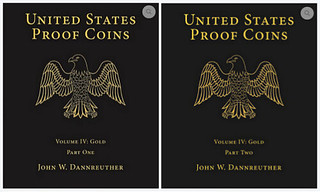 Before this work the only full-length treatise on United States Proof coins was Walter Breen’s 1977 encyclopedia that later was revised in 1989. Although that seminal book moved the
scholarship light years forward, its main drawback was its lack of illustrations. It was published before the digital age and was written on typewriter and laid out in the way books were done for
generations. Thirty-five-millimeter photographs were cut and pasted into a layout and that layout was converted to a transparency called a “blue.” From the blues, a printed book was produced.
Before this work the only full-length treatise on United States Proof coins was Walter Breen’s 1977 encyclopedia that later was revised in 1989. Although that seminal book moved the
scholarship light years forward, its main drawback was its lack of illustrations. It was published before the digital age and was written on typewriter and laid out in the way books were done for
generations. Thirty-five-millimeter photographs were cut and pasted into a layout and that layout was converted to a transparency called a “blue.” From the blues, a printed book was produced.
This volume on Proof gold has nearly 2,000 illustrations and every Proof gold variety either has a full color photograph or a close-up illustration of its pertinent features. This is only possible because of digital photography and software for a work of this magnitude. Details that previously only could be verbally described is now illustrated with such clarity that words are now secondary. Noting the date’s position by where an imaginary vertical line aligns with the left base of the 1 digit aligns with a dentil below it is still noted in this work, but many date positions have obvious other differences. Micro photographs of date positions illustrate these differences and allow easy identification of varieties.
After 1840, nearly all United States coins were produced from completely hubbed dies. Thus, the differences in Proof and circulation strike dies after this point often are the position of the hand-punched dates and little else. Reverse dies are even harder to differentiate, as the ones from Philadelphia (the majority of the Proof coins in this book) usually differ only in post-hubbing features. There is no mintmark in a different position for Philadelphia Proofs to distinguish varieties, as they do not have them!
In the past, collectors wanted one example of each date and Proofs were the ultimate collector coins. Today, collectors want both Proof and Mint State examples, so Proofs have lost some of their luster, as many collectors today have concentrated on rare circulation strike issues or common issues in very high grades. Admittedly, some of this focus is deserved, as there are many rare issues and there are numerous common-date coins that are very difficult to find in ultimate states of preservation. However, the collectors of the past appreciated the “Coiner’s Caviar” as Proofs were the best coins produced by the United States Mint and those throughout the world. Today, nearly every mint in the world produces Proof coinage – the ultimate examples of their coinage. Mints are proud of their coinage and Proof coins are the ultimate examples of their output. The care in producing and preparing the dies and planchets results in nearly perfect coins. They are miniature works of art!
Hopefully, these four volumes (this work on gold, followed by silver, copper, and nickel treatises) will cause a renaissance in collecting Proofs. In reality, Proof gold coins are among the most sought after and desirable issues in United States numismatics, but the other metals in the ultimate format have languished in recent years. Proof eagles and double eagles are highlights in dealer’s cases and auctions, just as one can imagine they were throughout the years past.
These four works will systematically identify every known Proof variety issued by the United States prior to 1916. By doing this, collectors will then be able to assemble variety sets of Proofs just as they do for large cents by Sheldon and Newcomb varieties, half dollars by Overton numbers, and the other circulation series that have been extensively studied and have had their varieties enumerated.
The author hopes that collectors, dealers, and others interested in numismatics will enjoy reading these works as much as the author enjoyed writing them. It is the culmination of a life-long fascination with the Mint’s pinnacle of their output – the best examples of the coiner’s work – Proof coins.
For more information, or to order, see:
https://www.orcararities.com/
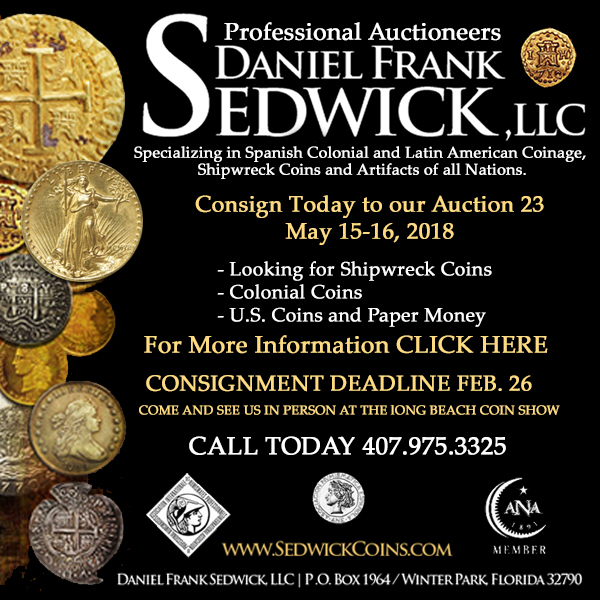
NEW BOOK: CONTEMPORARY COUNTERFEIT HALFPENNY AND FARTHING FAMILIES
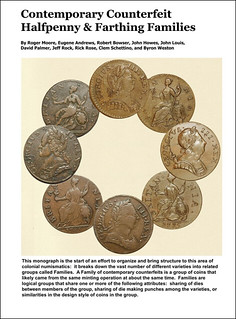 The Colonial Coin Collectors Club announces the latest in its series of publications -- CONTEMPORARY COUNTERFEIT HALFPENNY AND FARTHING FAMILIES, VOLUME ONE by Roger Moore, Eugene Andrews,
Robert Bowser, John Howes, John Louis, David Palmer, Jeff Rock, Rickie Rose, Clem Schettino, and Byron Weston.
The Colonial Coin Collectors Club announces the latest in its series of publications -- CONTEMPORARY COUNTERFEIT HALFPENNY AND FARTHING FAMILIES, VOLUME ONE by Roger Moore, Eugene Andrews,
Robert Bowser, John Howes, John Louis, David Palmer, Jeff Rock, Rickie Rose, Clem Schettino, and Byron Weston.
This monograph is the start of an effort to organize and bring structure to this area of colonial numismatics: it breaks down the vast number of different varieties into related groups called Families. A Family of contemporary counterfeits is a group of coins that likely came from the same minting operation at about the same time. Families are logical groups that share one or more of the following attributes: dies, die making punches, or similarities in the design style.
The work, large format, glossy hardcover, 304 pages and profusely illustrated in color will be available in March for $54.95 (plus $7.25 if shipped) from Charles Davis, P.O. Box 1, Wenham Mass 01984.
Comments on Contemporary Counterfeit Halfpenny and Farthing Families:
Jim Rosen
Past President, Colonial Coin Collectors Club, Inc.
“Finally, a wonderful and badly needed reference book of extraordinary importance that for the first time begins the monumental task of putting order to the unorganized field of counterfeit
halfpence and farthings.”
SECTION 1 -- Introduction
Historic Context of Non Regal Coppers
How to Collect Non Regal Coppers
Regal British and Irish Coinages
Formation of Non Regal Families
Understanding the Nomenclature on the Plates
Aid for Attributing Family Members
Glossary of Terms
Anton/Kesse Relationships with Families
SECTION 2 -- Quick Guide For Family Identification
SECTION 3 -- British And Irish Counterfeit And Evasion Families
INTRODUCTION – Moore
Chapter 1 – Aging George Family (AG) – Rose/Bowser
Chapter 2 – Baby Head Variety (BH) – Moore
Chapter 3 -- Banana Nose Family (BN) – Rock
Chapter 4 – Big Bird Family (BB) – Bowser/Moore
Chapter 5 – Boyish George Family (BG) – Moore
Chapter 6 -- British Toon Family (BT) – Rock/Louis
Chapter 7 – Capped Head Family (CH) – Moore
Chapter 8 – Coin X Family (CX) – Louis
Chapter 9 – Coin Y Family (CY) – Howes
Chapter 10 – Defiant Head Family (DH) – Howes
Chapter 11 -- Duke of Yorke Evasion Family (DYE) – Rock
Chapter 12 -- Faceless George Family (FG) – Andrews
Chapter 13 -- Flaming Sprig Family (FS) – Moore
Chapter 14 -- Indian Head Family (IH) – Rock/Bowser
Chapter 15 -- Irish Toon Family (IT) – Louis/Rock Chapter 16 – Lanky Letters Family (LL) – Moore
Chapter 17 -- Long Neck Family (LN) – Moore/Schettino
Chapter 18 – Machin Mills Family (MM) – Howes
Chapter 19 – Moody Pouty Family (MP) – Moore/Louis
Chapter 20 – Muted George Family (MG) – Louis
Chapter 21 – Notch Nose Family (NN) – Moore/Louis
Chapter 22 – Ogle Eye Family (OE) – Moore/Bowser
Chapter 23 – Old Guy George Family (OGG) – Rock/Louis
Chapter 24 – Potato Head Family (PH) – Moore/Rock
Chapter 25 – Rubber Lady Family (RL) – Moore/Rock
Chapter 26 – Simian George II Family (SGII) – Rose/Moore
Chapter 27 – Slope Head Family (SH) – Moore/Louis
Chapter 28 – Spike Chin Family (SC) – Moore/Louis
Chapter 29 – Swollen Jowl Family (SJ) – Moore
Chapter 30 – Teary Eyed Family (TE) – Andrews/Louis
Chapter 31 – Whistling George Family (WG) – Moore
Chapter 32 – Wood 42 Family (W42) – Moore
Chapter 33 – 1781 Family (81) – Moore/Palmer
Chapter 34 – 1785 Family (85) – Moore/Weston
SECTION 4 -- Summaries Of Incompletely Researched Families
Introduction – Rock/Moore
Bubblegum Face Family (BF) – Bowser/Moore
Coin W Family (CW) – Bowser/Moore
Coin Z Family (CZ) – Bowser/Moore
Crude American Family (CA) – Bowser/Moore
Curly Haired George Family (CG) – Bowser
Distant Bow Family (DB) – Bowser/Moore
Flat Struck Family (FS) – Bowser
Georgivs Triumpho Family (GT) – Moore/Bowser
Headless Rat Family (HR) – Bowser
Long Top Sevens Family (LT7) – Bowser/Moore
Proud Sevens Family (P7) – Bowser/Moore
Quill Pen Family (QP) – Bowser
Roman Head Family (RH) – Bowser
Ski Nose Family (SN) – Moore/Bowser
Slant Sevens Family (S7) – Bowser
Tilted Head Family (TH) – Bowser/Moore
Topless Ordinal Family (TO) – Bowser/Moore
Wedge Top Sevens Family (WT7) – Moore/Bowser
Young Head Family (YH) – Bowser/Moore
Bibliography And Suggested Readings: – Moore/Rock
For more information on the Colonial Coin Collectors Club, Inc., see:
http://colonialcoins.org/
For more information on the book, see:
http://www.numisbook.com/
BOOK REVIEW: GUNMONEY
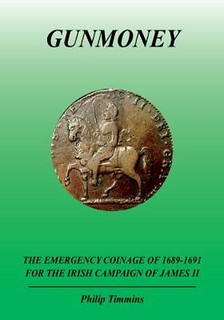 GUNMONEY: THE EMERGENCY COINAGE OF 1689-1691 FOR THE IRISH CAMPAIGN OF JAMES II
GUNMONEY: THE EMERGENCY COINAGE OF 1689-1691 FOR THE IRISH CAMPAIGN OF JAMES II
Philip Timmins
I have been a collector of the Gunmoney series for a few years now and have been frustrated by the lack of any reasonable reference. The papers and articles that have been published were contradictory. The most recent Spink reference, although a slight improvement on the last, was still lacking detail.
I was very excited to hear about the new publication by Philip Timmins and was not disappointed when it finally arrived. The book was laid out in a way that I was not expecting, using a timeline rather than by denomination. An added bonus was the synopsis of the conflict which, for those not already in the know, must bring life to the series. A refreshing change to the normal humdrum numismatic references out there.
The timeline of the Limerick mint was also tackled, and the conclusions drawn do make a lot of sense. Varieties in each denomination were tackled, and well illustrated where necessary. I am sure that as a result of the publication, many more varieties will surface from collections around the world. I imagine there will be some debate about what minor variations should constitute a separate reference. This has to be a good thing and no doubt an update to the reference will be published in a few years time detailing those new finds that surface as a result of this publication.
I imagine that this is now the reference that will be used worldwide when identifying coins in the series, and quite rightly so.
The publication of a reference work on the intriguing series of Irish Gunmoney has long been needed – partially because the series is so darned confusing, but also because there has been so much misinformation published over the last 300 years that collectors for too long haven’t really known what was out there. This admirable work by Timmins certainly fills that need, and corrects much of errors of the past.
The series was issued by King James II from 1689-1691 during his Irish campaign after he had been ousted from the British throne in the “Glorious Revolution” of 1688, mostly due to his embrace of Catholicism, but also over fear that he wanted to be an absolute monarch (his father, Charles I, didn’t fare too well in that role, having been executed in 1649).
The Gunmoney series was issued in a multitude of metals – gold, silver, copper, white-metal and a brassy base metal (the most common). The coinage was issued in an even larger number of denominations – crown, halfcrown (in both large and small sizes), shilling (also in small and large sizes), sixpence, groat and penny. The coins were issued from 1689-1691, as mentioned, but are rather unique in the annals of numismatics since they were issued every month between June of 1689 and October of 1690 (a 1691 issue collected with the series was issued in Limerick) – and the coins not only bear the year of their mintage but the month as well!
The month wasn’t an affectation on the part of the King, but rather a way to gradually replace the base metal coins with silver and gold if James II had succeeded – and, as an added bonus, the soldiers that served him would be able to not only exchange their base metal coins for silver and gold but also to claim interest on their wages, based on the date of the coinage. Since James II lost his bid to reclaim his crown this all came to naught – but remains an ingenious way to finance a war! Not all denominations or metals were issued in each month, and this has led to much of the confusion and uncertainty among collectors. Also adding to the confusion is that some issues were struck over earlier ones – but not over the same denominations. The smaller crowns, for instance, were struck over the earlier half crowns.
Timmins tackles this problem in the logical manner, moving month-by- month, not only listing the denominations that were issued but also going into die varieties for each denomination. The die varieties are often subtle in nature, and the author makes the attribution easy by giving enlarged illustrations of distinguishing characteristics (usually in the crown and date detail on the reverse side. The only minor drawback of the book is that while each obverse die is illustrated in full, the reverse dies are not – only the enlarged portions to distinguish the dies. This certainly saved space and decreased printing costs, but it would have been nice to have even if it added a few more pages to the work. The photographs are in color, slightly enlarged, and are overall of good quality – which is nice since the series is often found in wretched condition, and having nice examples to compare to definitely makes attribution easier.
Speaking of attribution, Timmins has devised a method that makes sense and is flexible enough to add new discoveries if they are made. The attribution numbers are a bit long, but there wasn’t any other option that combined utility and flexibility (simply numbering them from 1 to whatever the end of the series was has been proven the wrong way to do things ever since it was first used!). So a Timmins number may read: TB12B1-A. This number is basically shorthand for T(immins variety) B(ase metal) 12 (Shilling), June 1689 (the B) and Die Variety (1-A). The system is easy enough once you get the hang of it.
The book is more than just a listing of die varieties, however. The introduction gives a history of James II’s Irish campaign and the reasons these coins were needed. Each monthly chapter starts with an update of what happened in that month to the King trying to reclaim a throne, and they are fascinating reading, even if you know how things eventually worked out. The listings of the varieties give all the information needed to easily attribute, and the author gives remarks where needed. Just as useful as an accurate listing of varieties is the addition of a rarity scale (a bit different than the American version, this one has a dozen points ranging from C3 (extremely common) to R7 (just one or two known), and includes the charming category of N – “normal, neither scarce or common” which is really something the Americans should think of including in the future).
While not mentioned in the book itself, a fair number of Gunmoney coins have been found in archaeological contexts in North America, including in Colonial Williamsburg. Perhaps this is unsurprising since the British colonies here were often the dumping ground of coinage that was not wanted in England or Ireland. The William Wood coinage of Hibernia coppers may have circulated more in North America than in Ireland (especially after Jonathan Swift took aim at it), the 1760 Voce Populi coppers may have ended up here, and counterfeit Irish halfpence were sent here (along with their British counterparts) and are even found as undertypes for some of the early state coinages of the United States.
The book is nicely printed, in Ireland of course, and is published by The Numismatic Society of Ireland. While shorter than initially expected – just 146 pages – each page carries its weight, and the author gives you everything you need to know to collect and enjoy this fascinating series. It is well worth the price, even when factoring in expensive postage costs from Ireland to the US. David Fanning has noted that he will soon have the book available in the US, and that should help bring the postage cost down to collectors on this side of the Atlantic.
To read the earlier E-Sylum article, see:
NEW BOOK: GUNMONEY (http://www.coinbooks.org/v21/esylum_v21n03a04.html)

NEW PERIODICAL: VIETNAM NUMISMATICS
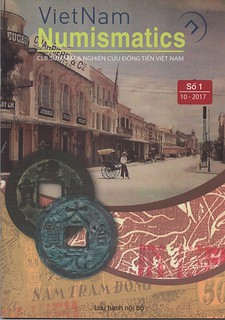 During my recent visit to Viet Nam, I was in Hanoi and met with Mai Ngoc Phat. Mr. Phat is an old friend who has assisted me in my numismatic research for many years. He is the primary
force and senior editor of a new magazine, VietNam Numismatics. He has also established a national numismatic club. There are now thousands of numismatists in Viet Nam and this magazine serves
them and overseas Vietnamese. It is written in Vietnamese and most of the articles are about old to modern coins, notes, tokens, etc., but there are articles about pieces from other parts of the
world.
During my recent visit to Viet Nam, I was in Hanoi and met with Mai Ngoc Phat. Mr. Phat is an old friend who has assisted me in my numismatic research for many years. He is the primary
force and senior editor of a new magazine, VietNam Numismatics. He has also established a national numismatic club. There are now thousands of numismatists in Viet Nam and this magazine serves
them and overseas Vietnamese. It is written in Vietnamese and most of the articles are about old to modern coins, notes, tokens, etc., but there are articles about pieces from other parts of the
world.
The first issue's cover and inside cover are attached. The oldest important Vietnamese numismatist; Nguyen Ba Dam, and the oldest important foreign numismatist; Howard A. Daniel III are pictured on the page. The picture with me includes my wife, Phung and Mr. Phat. He has also included the covers of my latest Vietnamese catalog, Democratic Republic of Viet Nam Coins & Currency.

Three issues of the magazine have been published. Nguyen Duc Viet is working with Mr. Phat and there is now a way of obtaining copies of the magazine for people who live outside of Viet Nam. Past, current and future issues can be obtained for US$10 each (which includes postage) by sending it to Mr. Viet via PayPal to his email address VIET@ueh.edu.vn. If anyone wants further information they can contact me at HADANIEL3@msn.com but Mr. Viet is also fluent in English.
CHINESE GUIDES FOR IDENTIFYING SILVER DOLLARS
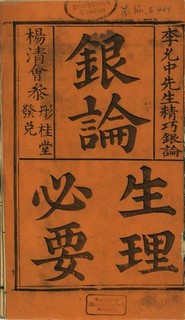 Mexican silver dollars, and other silver coins, were known and used in China in the Qing dynasty. They were often cut or stamped in China, and there are numerous examples of cut and
chop-marked dollars – there are examples in the British Museum Collection, and many more have been published in Chopmark News (there are copies of this journal online and print copies of later
issues in the library of the Dept of Coins and Medals at the British Museum). For a good introduction, with wonderful illustrations, see Joe Cribb’s Money in the Bank: The Hongkong Bank’s Money
Collection (published by Spink for the Hongkong and Shanghai Banking Corporation, 1987). For further detail, see Richard von Glahn’s article “Foreign Silver Coins in the Market Culture of
Nineteenth Century China”, International Journal of Asian Studies, vol. 4, issue 1 (Jan 2007), pp. 51-78.
Mexican silver dollars, and other silver coins, were known and used in China in the Qing dynasty. They were often cut or stamped in China, and there are numerous examples of cut and
chop-marked dollars – there are examples in the British Museum Collection, and many more have been published in Chopmark News (there are copies of this journal online and print copies of later
issues in the library of the Dept of Coins and Medals at the British Museum). For a good introduction, with wonderful illustrations, see Joe Cribb’s Money in the Bank: The Hongkong Bank’s Money
Collection (published by Spink for the Hongkong and Shanghai Banking Corporation, 1987). For further detail, see Richard von Glahn’s article “Foreign Silver Coins in the Market Culture of
Nineteenth Century China”, International Journal of Asian Studies, vol. 4, issue 1 (Jan 2007), pp. 51-78.
Abstract of von Glahn’s article: ‘Both the physical qualities of different types of money and the cultural values assigned to them contributed to the determination of their economic value. China
began to import substantial quantities of silver coins from Europe as early as the sixteenth century, but it was around 1800 that a foreign coin, the so-called “Carolus peso” issued by the Spanish
kings Carlos III and Carlos IV, became the basis of a new monetary standard in China, the yuan. In the nineteenth century the Carolus peso and imitations of it (mostly manufactured in China) served
as the principal means of exchange, and the yuan as the standard unit of account, in the markets of South China. This paper analyzes the monetary conditions that led to the establishment of the
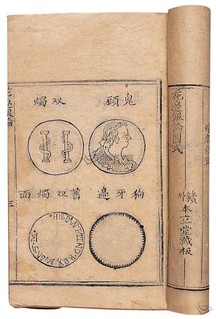 Carolus peso as the monetary standard of South China with particular consideration of the distinctive “currency circuits” formed by regional variations in monetary circulation. Significant
differences can be seen in the monetary regimes that prevailed in Jiangnan and Guangdong, the major commercial centers of the empire. While Guangdong reverted to a commodity money standard that
allowed the use of a wide range of different types of physical monies, including “chopped” and broken foreign coins, in Jiangnan the Carolus peso became a unified, fiduciary monetary standard. This
regional variation attests to the distinctive regional characteristics of market culture in late imperial China.’
Carolus peso as the monetary standard of South China with particular consideration of the distinctive “currency circuits” formed by regional variations in monetary circulation. Significant
differences can be seen in the monetary regimes that prevailed in Jiangnan and Guangdong, the major commercial centers of the empire. While Guangdong reverted to a commodity money standard that
allowed the use of a wide range of different types of physical monies, including “chopped” and broken foreign coins, in Jiangnan the Carolus peso became a unified, fiduciary monetary standard. This
regional variation attests to the distinctive regional characteristics of market culture in late imperial China.’
Finds of Mexican silver dollars are reported in Chinese numismatic journals, and sometimes make a splash in the local press: see, for example, the hoard of hundreds of silver dollars found in Longhai Village (Fujian province), in 2011, which Gary Ashenkazy highlighted on his blog Primaltrek.
To read the complete article, see:
CHINESE GUIDES FOR IDENTIFYING SILVER DOLLARS AND OTHER
COINS, 19TH CENTURY (https://chinesemoneymatters.wordpress.com/2018/02/16/41-chinese-guides-for-identifying-silver-dollars-and-other-coins-19th-century/)

NEWMAN NUMISMATIC PORTAL 2017 REPORT
A growing community resource

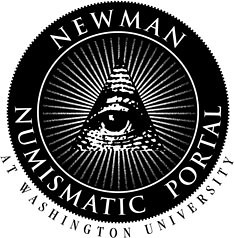 Numismatic collections, journals and auction catalogs … not long ago, these gems were rare and uncirculated. Or at least a distant archive away. Today, many are easily and instantly viewed
– at no cost to users – on the Newman Numismatic Portal (www.NewmanPortal.org). And more content is constantly added by those in the numismatic community, from major organizations to individual
researchers.
Numismatic collections, journals and auction catalogs … not long ago, these gems were rare and uncirculated. Or at least a distant archive away. Today, many are easily and instantly viewed
– at no cost to users – on the Newman Numismatic Portal (www.NewmanPortal.org). And more content is constantly added by those in the numismatic community, from major organizations to individual
researchers.
Thanks to such enthusiastic input, the Newman Portal came a long way in 2017, its first full year of operation. Among the 20,000 documents, images and other media now available on this easily used internet site:
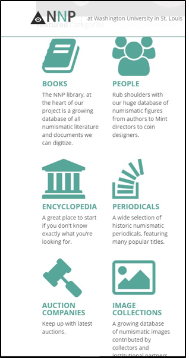 Auction catalogs: Stack’s Bowers and Kagin’s opened their historic auction catalogs for scanning. The Stack’s Bowers auction sale catalogs, from 1935 to date, cover 800 distinct
sales while Kagin’s, beginning in 1940, contributed 295 catalogs for inclusion on the Newman Portal. Heritage Auctions has linked its comprehensive online auction archives, listing nearly 3 million
auction lots, to the Newman Portal. Heritage Auctions has linked its comprehensive online auction archives, listing nearly 3 million auction lots, to the Newman Portal.
Auction catalogs: Stack’s Bowers and Kagin’s opened their historic auction catalogs for scanning. The Stack’s Bowers auction sale catalogs, from 1935 to date, cover 800 distinct
sales while Kagin’s, beginning in 1940, contributed 295 catalogs for inclusion on the Newman Portal. Heritage Auctions has linked its comprehensive online auction archives, listing nearly 3 million
auction lots, to the Newman Portal. Heritage Auctions has linked its comprehensive online auction archives, listing nearly 3 million auction lots, to the Newman Portal.
The ANS library: The American Numismatic Society, in addition to hosting Newman Portal scanning equipment in its library, has made extensive contributions to the Portal by releasing published content for open access. These titles include the American Journal of Numismatics, Numismatic Notes and Monographs, ANS Magazine and Coinage of the Americas Conference proceedings, and the Virgil Brand ledgers from the ANS library, documenting one of the most important American collections at the turn of the 20th century. ANS trustee Dan Hamelberg has made his incomparable personal library of American numismatic literature available for scanning.
The ANA’s Numismatist. The American Numismatic Association made The Numismatist available on a search-only basis through the Newman Portal. For a full view, see https://www.money.org/thenumismatist/digitalarchives .
Specialized collections. Collectors including Alan Weinberg and Arnold-Peter C. Weiss have contributed images of outstanding collections of medals, as has the owner of the Eclectic Numismatic Treasure collection of exonumia. Two comprehensive collections of numismatic postcards, from Bob Merchant and David Sklow, are viewable on Newman Portal, with the Mark Borckardt collection currently in processing. These curated images can now be viewed in a text-searchable format.
Club publications. Numerous numismatic organizations and societies have partnered with Newman Portal to digitize their publications, which serves the dual purpose of archiving their specialized content for posterity and promoting the organization through open access on the Internet. This is done at no cost to contributing organizations, and many joined NNP in 2017, as the number of individual and organization contributors nearly doubled, from 35 to 69. Among these were the John Reich Collector Society, Numismatic Literary Guild, Society of Paper Money Collectors, Fly-In Club, Florida United Numismatists, National Scrip Collectors Association, and the Fractional Currency Collectors Board.

Continued growth of the Newman Portal will be fueled by the numismatic community. As more and more individuals and organizations participate, the Portal becomes a greater resource for all. This was the vision of numismatist extraordinaire Eric P. Newman, who died in 2017 at the age of 106. As a researcher and author, Newman recalled: “We didn’t have everything on microfilm in the early days, we didn’t have everything on computer. We had to go from library to library and read every bit of it and make notes and try to piece together all the wonderful information that was out there.”
In launching his namesake portal, Newman ensured that numismatic research and archival storage move into the 21st century. And that this “wonderful information” is just an internet search away. The Eric P. Newman Numismatic Education Society is carrying on his mission: to bring the literature and images of American numismatics – free and online – to collectors and researchers.
The Newman Numismatic Portal is sponsored by the Eric P. Newman Numismatic Education Society and administered by Washington University in St. Louis. Queries regarding NNP usage or content may be directed to NNPCurator@wustl.edu.
To visit the Newman Numismatic Portal, see:
www.NewmanPortal.org

1875-1907 U.S. COINAGE LEDGERS DIGITIZED
U.S. Coinage Ledgers for 1875-1907 Digitized at the National Archives
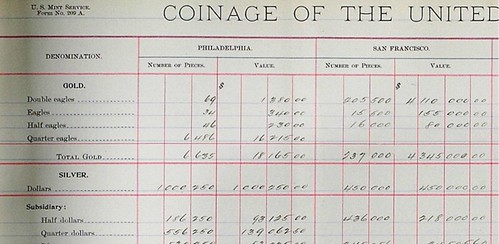
Did you ever wonder where the mintage figures in the Guide Book of United States Coins come from? In most cases they’ve been ferreted out piece by piece from U.S. Mint records at the National Archives (NARA). Walter Breen, under the sponsorship of Wayte Raymond, did much of this work in the 1950s. Complicating the research is that there is no single source at NARA where this information is recorded. The information is where you find it, and to this end Roger W. Burdette has recently digitized six ledgers covering daily and monthly coinage reports, by Mint, for the period 1875-1906. These volumes are available on Newman Portal, and now anyone can investigate these mintage figures directly from the original source. Sharpen your calculator, and you might find a mistake in the Red Book!
Link to U.S. Mint coinage figures from the National Archives on Newman Portal:
https://nnp.wustl.edu/library/archivedetail/524535
NEWMAN PORTAL SEARCH: BLACK BESS
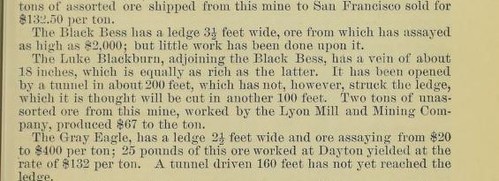
This week a Newman Portal user searched for the term “Black Bess.” Newman Portal identifies but a single useful source, the 1882 Annual Report of the Director of the Mint Upon the Production of Precious Metals. “Black Bess” refers to a mine in Roop County, NV, in the northwestern part of that state. The Report states of this area
“The district is claimed by men of limited means who are working in a very moderate way.”
Of the Black Bess specifically it reports
“The Black Bess has a ledge 3 feet wide, ore from which has assayed as high as $2,000; but little work has been done upon it. The Luke Blackburn, adjoining the Black Bess, has a vein of about 15 inches, which is equally as rich as the latter. It has been opened by a tunnel in about 200 feet, which has not, however, struck the ledge, which it is thought will be cut in another 100 feet. Two tons of unassorted ore from this mine, worked by the Lyon Mill and Mining Company, produced $67 to the ton.”
Image: extract from the 1882 Annual Report of the Director of the Mint Upon the Production of Precious Metals
Link to Annual Reports….upon the Production of Precious Metals (1880-1909) on Newman Portal:
https://nnp.wustl.edu/library/publisherdetail/510307
THE BOOK BAZARRE
DICK JOHNSON ON THE 2018 WINTER OLYMPIC MEDALS
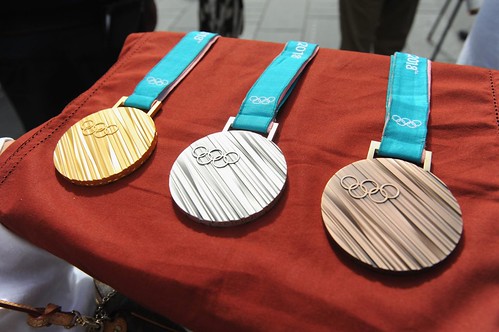
OLYMPIC MEDAL DESIGN A TRAVESTY
To the makers of the 2018 Winter Olympic medals credit, the alternating gold and silver striation design is a touch of allure. It has the cost benefit of using less plated gold than what would be necessary had the entire surface been goldplated. This is applicable only to the gold Medals; the silver and bronze versions are solid unplated.
Overall, however, the design is a disappointment. The medal’s creator stated the design indicates tree bark. How is this appropriate to the Olympic events? – or the winter season? The striated design of multiple streaks is a textural treatment. As such it is minimal art, the complete opposite of the basic characteristics of art medals which relish detail.
Previous Olympic medals followed this tenet with detailed designs significant to the Olympic events. Let us hope future Olympic medal designers don’t carry this trend forward. If so the result would be the five Olympic ring symbol, about as minimal as could be depicted on the official medals.
To read the earlier E-Sylum article, see:
THE 2018 WINTER OLYMPIC MEDALS (http://www.coinbooks.org/v21/esylum_v21n06a33.html)
VALUING THE 2018 WINTER OLYMPIC MEDALS
“As a precious metals wholesaler, we get this question of value every two years or so when the Olympic Games come around,” said Terry Hanlon, president of Dillon Gage Metals, one of the world’s largest precious metals wholesale firms. “First and foremost, the first place medals aren’t solid gold but rather silver with gold plating. If they were 100 percent pure, they’d be worth quite a bit and would obviously be much heavier too.”
The gold medal, each of which is actually comprised of 99.9 percent silver with six grams of plated gold, weighs 586 grams. The silver medal weighs 580 grams, and the bronze weighs 493 grams.
In calculating a gold medal’s worth, the first part of the equation includes its composition of 99.9 percent silver and weight of 580 grams. It takes 31.1033 grams to equal a Troy ounce. The current price of silver is trading at about $17 USD, so it follows the silver portion of the gold medal is worth about $318 USD.
To read the complete article, see:
2018 Olympic gold medal value (https://canadiancoinnews.com/2018-olympic-gold-medal-value/)

NOTES FROM E-SYLUM READERS: FEBRUARY 18, 2018
Found in Books
 Bob Rightmire writes:
Bob Rightmire writes:
In response to what we found in old books, the readership might be interested in Forgotten Bookmarks, A Bookseller’s Collection of Odd Things Lost Between the Pages of Books, by Michael Popek, NY: A Perigee Book, 2011.
Dennis Forgue writes:
Back in 1989-1990 or so during my second stint at Rarcoa in their new offices in Willowbrook, an elderly man and his daughter came in. With them were thirty or so $500 and $1000 bills. The man’s wife had died from Alzheimer’s and they were clearing out the house to sell it. While packing up the library to donate, one of the bills fell out of a book. He had no idea where it came from. They carefully went through all the books and found the treasure trove. Other searching of the house found more under the runners on the stairs going to the second floor. Where the wife got the money was a mystery, but he figured she was careful with the butter and egg money.
Dick Johnson writes:
I once bought a copy of T.C. Compartette’s Catalogue of Coins, Tokens and Medals in the Numismatic Collection of the Mint which had a dozen or so four-leaf clovers inside. Symbols of Good Luck, four-leaf clovers could be preserved by drying out between pages of a book but left a stain on both pages.
I remember as a youth our backyard was full of clover. The children frequently found four and five-leaf clovers, and rarely six and seven leaves, instead of the usual three.
To read the earlier E-Sylum article, see:
WHAT HAVE YOU FOUND IN OLD BOOKS? (http://www.coinbooks.org/v21/esylum_v21n06a23.html)
1883 Article on the No Cents V Nickel
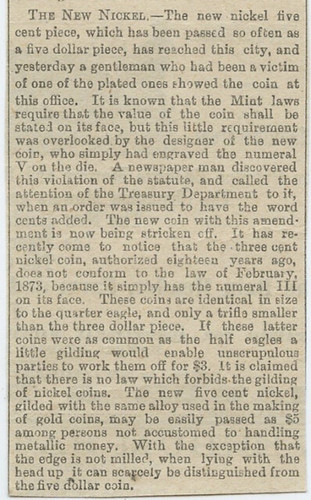
More on the Stone Mountain Countermarks
John Lyons writes:
• There is an excellent Numismatic Theater Presentation by Adna G. Wilde, Jr. that is 46 minutes in length and covers extensive information on the carving, the distribution of the counter-stamps, numbering, population and auction results. It was produced at the Atlanta ANA Convention in 2001. The ANA library initially had VHS tape copies available.
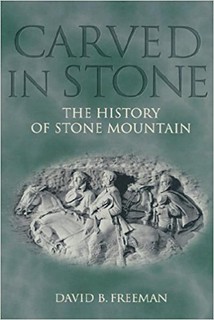 • There were actually two four piece sets of medals issued in 1970. One set was issued by the US Mint and includes a large and small silver medal and a large and small silver bronze
medal. The Medallic Art Co. also produced a very similar 4-piece set, with the same designs in 1970. Their medals are slightly smaller than the Mint’s set and do not have the “P” mintmark on the
reverse that is visible on the Mint editions.
• There were actually two four piece sets of medals issued in 1970. One set was issued by the US Mint and includes a large and small silver medal and a large and small silver bronze
medal. The Medallic Art Co. also produced a very similar 4-piece set, with the same designs in 1970. Their medals are slightly smaller than the Mint’s set and do not have the “P” mintmark on the
reverse that is visible on the Mint editions.
• The book “Carved in Stone, The History Of Stone Mountain” by David B. Freeman published in 1997 also is an interesting read about the town, the carving’s history and mentions in several places the coins and medals produced to help fund the carving.
To read the earlier E-Sylum article, see:
MORE ON THE STONE MOUNTAIN COUNTERMARKS (http://www.coinbooks.org/v21/esylum_v21n06a14.html)
On Mainstream Reporting of Numismatics
David Fanning writes:
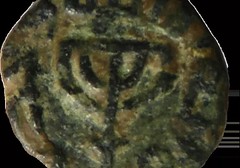 The news article beginning “Researchers recently discovered that menorahs prominently adorned Muslim coins and vessels during the early Islamic period 1,300 years ago,” is just another
example of clueless mainstream reporting of numismatics. Islamic coins featuring these designs have been known to numismatists for centuries. There’s nothing new about them. The article reminds me of
the news articles that come out every few years announcing the “discovery” of coins featuring Cleopatra and expressing their shock that she didn’t resemble Liz Taylor.
The news article beginning “Researchers recently discovered that menorahs prominently adorned Muslim coins and vessels during the early Islamic period 1,300 years ago,” is just another
example of clueless mainstream reporting of numismatics. Islamic coins featuring these designs have been known to numismatists for centuries. There’s nothing new about them. The article reminds me of
the news articles that come out every few years announcing the “discovery” of coins featuring Cleopatra and expressing their shock that she didn’t resemble Liz Taylor.
To read the earlier E-Sylum articles, see:
MUSLIM COIN FEATURES MENORAH SYMBOL (http://www.coinbooks.org/v21/esylum_v21n06a28.html)
ARCHEOLOGY AS A POLITICAL WEAPON (http://www.coinbooks.org/v21/esylum_v21n06a29.html)
On a related note, Dave Lange writes:
The allegedly counterfeit UK pound coin appears to be simply a mint error known as a partial collar strike. It's always amazing that the general press never reaches out to someone with numismatic knowledge, but then that would kill a good story.
To read the earlier E-Sylum article, see:
HAS THE UNFAKABLE POUND COIN BEEN FAKED? (http://www.coinbooks.org/v21/esylum_v21n06a31.html)
Why George VII Doesn't Have a Crown (Yet)
 Regarding the new crown representing the four living generations of the British Royal family, last week I asked, "And how come poor George doesn't get his own crown on the coin?
Artistic license, or a foreshadowing of the fall of the House of Windsor? Hmmmm."
Regarding the new crown representing the four living generations of the British Royal family, last week I asked, "And how come poor George doesn't get his own crown on the coin?
Artistic license, or a foreshadowing of the fall of the House of Windsor? Hmmmm."
David Pickup writes:
The House of Windsor is secure, thank you! The initials are code for Commonwealth Will Gain Even more. It refers to the Declaration of Independence lapsing and USA joining the Empire again.
Coin World copy editor Fern Loomis writes:
Note designer Noad’s explanation: Noad said, "Prince George won’t have his own coat of arms or coronet until he’s 18.”
To read the earlier E-Sylum article, see:
NOTES FROM E-SYLUM READERS: FEBRUARY 11, 2018 : An Observation on the Four Generations Coin
(http://www.coinbooks.org/v21/esylum_v21n06a13.html)
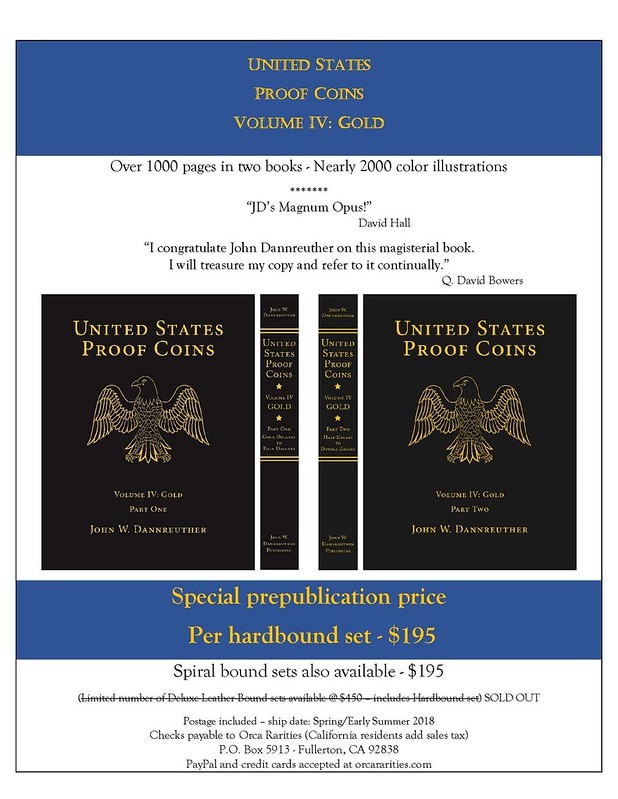
"ISIS COIN" IS IRAQI REPUBLIC PIECE
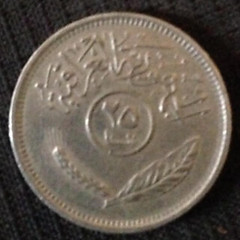
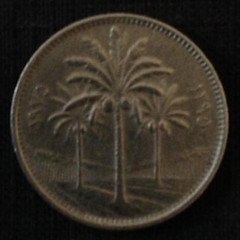
Iraqi Republic 25 fils
Ken Spindler of San Diego writes:
I don't read Arabic beyond about five words and the numbers, but the lower image coin shown under MORE IMAGES OF ISIS COINAGE certainly appears to be a common 25 fils coin of Iraq, 1975/AH 1395, KM-127; mintage 48 million - from long before "ISIS."
Chip Howell agrees. He writes:
That bottom coin looks to be an Iraqi Republic 25 fils, 1975/1395AH.
To read the earlier E-Sylum article, see:
MORE IMAGES OF ISIS COINAGE (http://www.coinbooks.org/v21/esylum_v21n06a30.html)
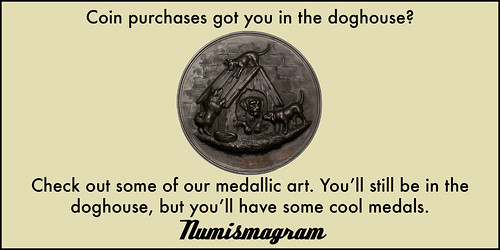
MORE ON THE CAPONE AND LINDBERGH CASES
On both the Capone and Lindbergh cases the lead agent was Frank J. Wilson, who later took over as Chief of the Secret Service and supervised the 1933 double eagle case.
On Agent Mike Malone
Regarding Malone, here is how Wilson described him in his autobiography “Special Agent”:
“My other undercover man on the Capone case was my “secret weapon,” our own “Mysterious Mike Malone,” with whom I had worked on the McConnell case and who I thought then, and still think, was the greatest natural undercover worker the Service has ever had. Five feet, eight inches tall, a barrel-chested, powerful two hundred pounds, with jet black hair, sharp brown eyes underscored with heavy dark circles and a brilliant, friendly smile, Mike could pass easily for Italian, Jew, Greek, or whomever the occasion demanded.” (p. 33)
On the Lindbergh Kidnaping
Frank Wilson was the man who suggested recording the serial numbers of the ransom (“A dozen of [J.P.] Morgan Company’s bookkeepers stayed up most of the night recording….”). The kidnapper stipulated
the ransom ($50,000) be $25,000 in $20s; $15,000 in $10s; and $10,000 in $5s.
Regarding the gold notes: “We purposely included $25,000 in gold certificates, because there were fewer of these bills in circulation and they could be spotted by bank tellers much more easily than other types of bills.” (p. 61)
These guys were all pretty amazing. Wilson shortly after the Lindbergh case took over the Secret Service (1936).
To read the complete article, see:
TREASURY LAW ENFORCEMENT ON STRANGE INHERITANCE (http://www.coinbooks.org/v21/esylum_v21n06a22.html)
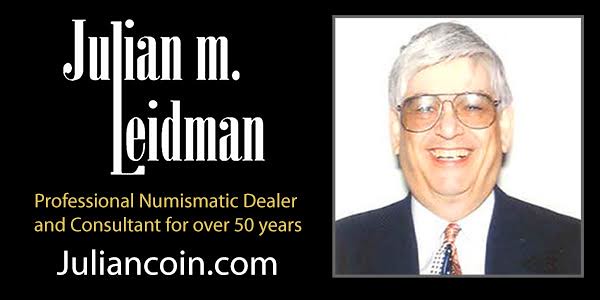
VOCABULARY TERMS: DIE STATE, DIE VARIETY
Here are two numismatic terms often confused describing two or more similar specimens. They differ in the number of dies involved. Read on.
Die State. A discernible stage of a production die from freshly cut and hardened, through stages of wear, DIECRACKS, diebreaking, DIE CLASH (if any), and finally,
rusting. Each of these stages would produce a struck piece showing evidence of the die’s condition or deterioration. The term die state (as differing periods in a die’s lifetime) is in contrast to
DIE VARIETY (each from a different die). Differing die states would also show advancing evidence of DIE WEAR. Once something happens to a die, it never returns to a previous die state – all
deteriorating effects are cumulative. Thus it is an advanced numismatic study to determine the die state sequence of a particular die which is termed SEQUENCE EMISSION.
CLASS 11.4
Die Variety. A struck numismatic piece of distinct variety identifying a die different from a similar piece. No two dies are exactly alike. It is of interest to numismatists and collectors to determine as many different dies and die stages as possible; this is accomplished by studying as many specimens possible, noting differences in detail, dates, lettering, figures and ornaments to distinguish each variety. Identifying each such stage and cataloging every known die variety advances numismatic science.
Prior to the mid 19th century all dies were cut by hand – each die was different – thus the opportunity for varieties was extensive. DIE LIFE was shorter than in later times; and since the effort to produce as many pieces as possible from the die, everything was done to prolong its usefulness, including OVERDATING, retooling and utilizing dies in early stages of deterioration. An unbroken die that was not overly worn at the end of the year was RE-ENGRAVED or punched with the following year’s date and put back into production. Thus overdates are the most extensive examples of die varieties.
The rise of HUBBING in the 19th century reduced the number of die varieties – since uniform working dies could be made from the same master die – but hubbing created some die varieties of its own,
notably DOUBLING. See DIAGNOSTIC DETAIL, DIE LIFE, STATE.
CLASS 11.4
REFERENCE: NE42 {1982} DOTY, P 103-104.
Looking for the meaning of a numismatic word, or the description of a term? Try the Newman Numismatic Portal's Numismatic Dictionary at: https://nnp.wustl.edu/library/dictionary

ALFRED SEYMOUR ROBINSON (1836-1878)
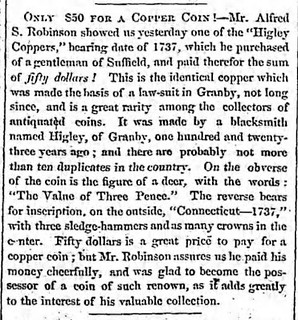 Alfred Seymour Robinson (1836-1878), was born on April 6, 1836, at Hartford, Connecticut, son of David Franklin Robinson (1801-1862), a bank president and commercial real estate owner, and
Anne Seymour Robinson (1801-1892).
Alfred Seymour Robinson (1836-1878), was born on April 6, 1836, at Hartford, Connecticut, son of David Franklin Robinson (1801-1862), a bank president and commercial real estate owner, and
Anne Seymour Robinson (1801-1892).
Following in his father's footsteps Alfred S. Robinson became a banker in the Banking House of George P. Bissell &Company, 309 Main Street, Hartford, Connecticut from May 1, 1857 to July 1,
1861. Afterwards he continued as a banker on his own account as a Banker, Broker, Notary Public, Dealer in Stocks, Bonds, Notes, Land Warrants, Uncurrent Money, and All Kinds of American and Foreign
Specie.
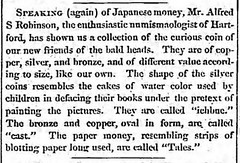
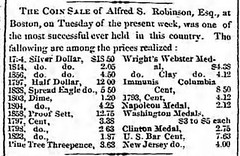
He was active in local politics and was secretary of the Citizens' Caucus, and served on the Third Ward Committee.
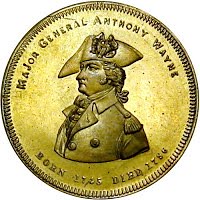 In the 1860's he issued a series of tokens including the "Alfred S. Robinson's Historical Series", the unique Day, Griswold &Co. store card, and copies of colonial coins
including a Brasher doubloon.
In the 1860's he issued a series of tokens including the "Alfred S. Robinson's Historical Series", the unique Day, Griswold &Co. store card, and copies of colonial coins
including a Brasher doubloon.
He died on September 23, 1878, at Hartford, Connecticut. He is buried at Old North Cemetery, Hartford, Connecticut.
To read the complete article, see:
ROBINSON, ALFRED SEYMOUR
(https://sites.google.com/a/numismaticmall.com/www/numismaticmall-com/robinson-alfred-seymour)
The entire inventory of the Lupia Numismatic Library is for sale. Individual items will be available before the remaining archives are broken up into parcels sold at philatelic auctions in the U. S. and Hong Kong. Check NumismaticMall.com frequently as dozens of new items with estimates will be posted daily until everything is sold.
All inquiries will be given prompt and courteous attention. Write to: john@numismaticmall.com .
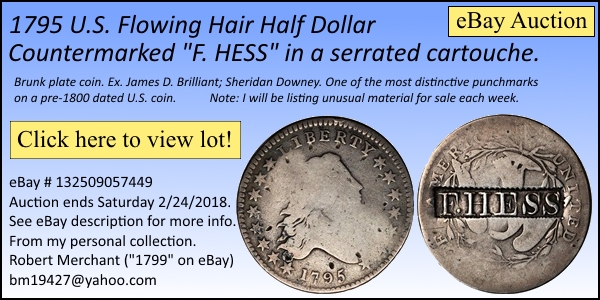
THE A.J. VANDERBILT COLLECTION
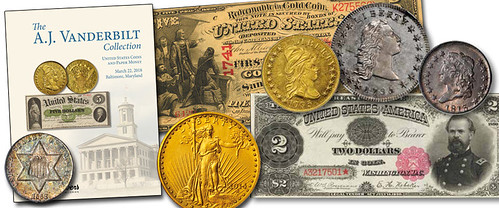
Did you know A. J. Vanderbilt starting buying coins from Stack’s Rare Coins in New York City in 1936, at the age of 15? We are proud to present the A.J. Vanderbilt Collection of U.S. Coins and Currency at our upcoming official auction of the Whitman Coin and Collectibles Spring Expo.
In 1926, an emergency appendectomy put a curious, intelligent 5-year-old boy in bed for an extended period of time. His concerned mother wanted to find a way to keep him still so that he could heal from surgery. She had come up with a few ideas, but the one that he seemed to enjoy the most was sorting through a large bag of pennies she had brought home from the bank. He would sit for hours, looking at them with a magnifying glass and categorizing them by date, mint and condition. The seed was planted, and a coin collector was born.
In 1936, at the age of 15, he started buying and selling through Stack’s Rare Coins in New York City. He was their youngest client and worked with them until his death at age 96.
He traveled the United States and visited many banks to find the newest and best coins he could. After joining the Navy and serving in the Pacific during World War II, he started a collection of foreign coins, but only from places he had visited.
After World War II ended and he received his PhD, the collector went to work for the government in Washington, DC. His job required a fair amount of travel, giving him the opportunity to add to his foreign collection. He was also in much closer proximity to New York and Stack’s. With the help of the Stack’s brothers, his collection grew into what is one of the finest in the country.
For his family, it was fun to see his face when a box from Stack’s arrived at the house. He would first examine the box to check the seal. Then his pocketknife came out and he precisely sliced the tape. The lid was raised with reverence; he would almost be holding his breath. And, there in that little brown box was a small envelope with a plastic bag inside holding a beautiful coin. His eyes would light up as he removed the coin, holding it only by the rim. Out came the magnifying glass to check for any scratches or marks. He was truly like a kid in a candy shop. After he looked it over, my mother and I would be called into the room to see the new addition to his collection. After much oohing and aahing, he would place the coin back into the little plastic bag and set it on his desk so he could look at it again later.
There is something almost magical about these coins, not only their physical beauty but also wondering where they had been, who had held them in the past and where they might have traveled. The man who collected them truly cared for his coins, not just their value, but their history as well.
The family this collector left behind hopes those who purchase his coins and paper money will find them just as beautiful and interesting as he did, and that they will make new history with them.?
To read the complete article, see:
Did You Know? About the A.J. Vanderbilt Collection
(http://www.stacksbowers.com/News/Pages/Blogs.aspx?ArticleID=2853)
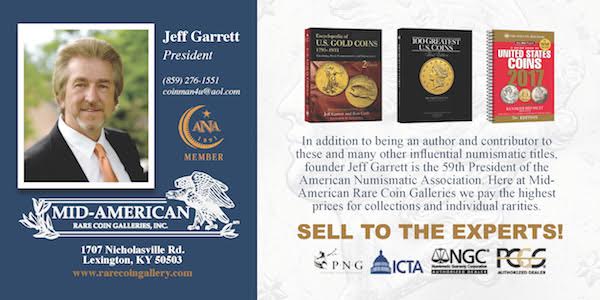
DON BAILEY: DEAN OF MEXICAN NUMISMATICS
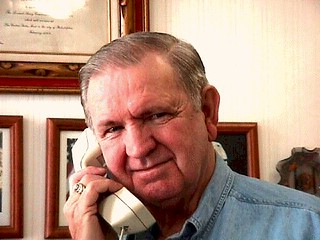 Don Bailey is one of the most well-known American specialists in the coinage of Mexico, whose interest in Mexican coins began in the 1960s. Since then he has developed a reputation as an
internationally-recognized expert in his field and has done more than any other American coin dealer to promote interest in Mexican coins and make those numismatic items available to collectors in
this country.
Don Bailey is one of the most well-known American specialists in the coinage of Mexico, whose interest in Mexican coins began in the 1960s. Since then he has developed a reputation as an
internationally-recognized expert in his field and has done more than any other American coin dealer to promote interest in Mexican coins and make those numismatic items available to collectors in
this country.
Born and raised in Michigan, Don left the state during the Korean War to join the U.S. Marine Corps. When he retired from the Marines, he was living in Yuma, Arizona, a state that borders Mexico, where he resided for seventeen years. It was in Arizona that Don began his love affair with Mexican coins and the history behind them.
To truly appreciate and understand the coins of a country, it is essential to study them and the country’s history in depth and to interact frequently with others who share your interests. This is exactly what Don and his wife Lois have done for almost sixty years in the field of Mexican numismatics.
Don first started collecting U.S. coins in the early 1960s but soon developed a real passion for Mexican coins. He initially concentrated on the coinage Maximillian and French Intervention periods in the 19th century when French emperor Napoleon III installed the Archduke Ferdinand Maximillian of Austria to rule Mexico.
Don’s deep interest in Mexican history and coinage led him to study and write about them with his first article appearing in 1967. These articles have focused mainly on Mexican historical and numismatic subjects and have appeared in every major numismatic publication, including some that no longer exist. They have ranged from articles about new issues and the state of the market for Mexican coins to more scholarly examinations of Mexican coinage since its origins in the Aztec period.
In recognition of his many contributions to the study of Mexican coins, he has received numerous literary and distinguished service awards. These include, for example, the American Numismatic Association’s Presidential Award, being named a Numismatic Ambassador by Numismatic News, and several awards from Mexico, including in 2001 the Mexican Order of the Aztec Eagle, the highest honor the Mexican government can bestow on a foreigner. He also received the Tidwell literary award from the Texas Numismatic Association and many awards from the Numismatic Literary Guild over an extended period for his articles and books.
It is impossible to summarize the full breadth of the wide-ranging contributions of Don Bailey to Mexican numismatics over the past half century, which have received widespread recognition within the U.S. and Mexico. But perhaps Beth Deisher put it best when she said in her foreword to the second volume of Mexican Money: “Don’s driving vision for the last 40 years has been to share his knowledge and to entice others to become as smitten with Mexican numismatics as he was. Don and Lois (his wife and numismatic research partner) can take pride in knowing they’ve succeeded.”
To read the complete article (scroll down), see:
A biography of Don and his Incomparable Contributions to Mexican Numismatics (http://donbailey-mexico.com/about.shtml)

ANNE JESSOPP TO LEAD ROYAL MINT
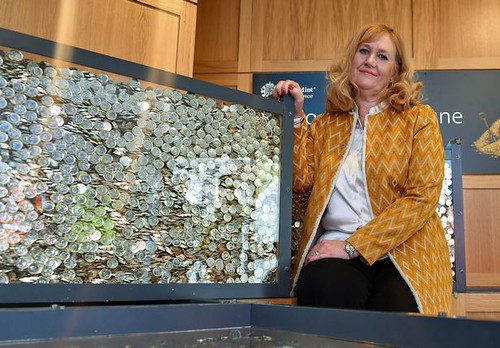
The Royal Mint have appointed Anne Jessopp as its new chief executive and Deputy Master of the Mint.
She will lead work to provide Britain with its cutting-edge secure currency and will also develop the commemorative coin and bullion arm of the business.
On a visit to the Royal Mint, the Exchequer Secretary officially confirmed Anne Jessopp’s appointment - the first female to take up the role in the Royal Mint’s 1,100 year history.
As chief executive of the Royal Mint, Ms Jessopp will be tasked with running the Great British institution which produces up to 90 million coins every week.
Speaking of her new appointment Ms Jessopp said: "I am delighted to be appointed to lead this unique and important British organisation.
"The Royal Mint has an impressive history of over 1,100 years and its longevity is due to its ability to adapt as society changes.
"This was never truer than today, as we reinterpret The Royal Mint for the 21st century, building on the values that have been at the heart of the organisation throughout our history - authenticity, security, precious metals, craftsmanship and design.
"I have had the privilege to work for The Royal Mint for almost 10 years and it is testament to the great colleagues and opportunities I have had, that I have been able to develop the skills that enable me to take on this role."
One of Jessopp's first tasks will be overseeing the introduction of the new 50 pence coin, a special design that commemorates the 100th anniversary of women getting the right to vote in Britain.
Jessopp, who previously worked for Procter &Gamble (PG), will also lead the annual Trial of the Pyx, a historical ceremony that tests the integrity of the country's coins.
Tradition dictates that if the coins are found to be faulty, the Chancellor of the Exchequer (finance minister), who is the ceremonial Master of the Mint, will lose a hand as punishment.
"It should be made clear that in the trial's long history, 94 Minters have had their right hands cut off by order of the King. However, this has not happened for hundreds of years," the Mint said in its statement.
To read the complete article, see:
Royal Mint gets first woman boss in 1,100 years
(http://money.cnn.com/2018/02/16/news/royal-mint-female-boss/index.html)

AUSTRALIA'S OLD TREASURY BUILDING MUSEUM
 While I was in Viet Nam I was sitting with an old Vietnamese collector-friend at the Sunday morning meeting of collectors in Ho Chi Minh City (Saigon). He had just returned from Melbourne,
Australia where he bought a house and will be moving there after selling his assets in Viet Nam. He visited Melbourne's "Old Treasury Building" and told me the gold ingot and nugget
exhibits were very impressive, and when I visit him there we HAD to go see them, and there was no admission cost!
While I was in Viet Nam I was sitting with an old Vietnamese collector-friend at the Sunday morning meeting of collectors in Ho Chi Minh City (Saigon). He had just returned from Melbourne,
Australia where he bought a house and will be moving there after selling his assets in Viet Nam. He visited Melbourne's "Old Treasury Building" and told me the gold ingot and nugget
exhibits were very impressive, and when I visit him there we HAD to go see them, and there was no admission cost!
I have attached a flyer with more information that he gave me and thought this might be of interest to readers who will be visiting Australia.
For more information, see:
https://www.oldtreasurybuilding.org.au/
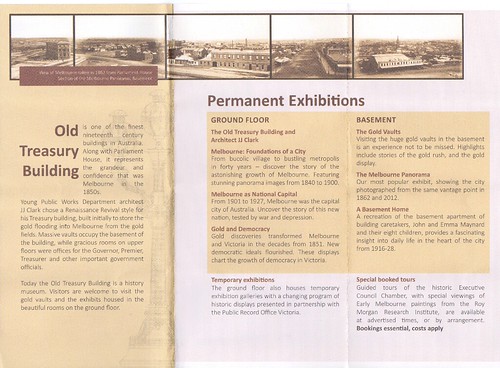
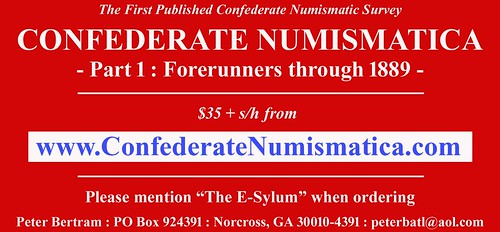
BEWARE THE COIN SWAP TRICK
 The Tidy House Swap
The Tidy House Swap
Here’s an egregious example of the swapped out Tidy House silver dollar, replacing the Morgan with an Extra Fine cleaned and retoned Peace dollar. In the 1960s, Tidy House used Morgan dollars, after
buying several $1,000 bags for its promotion from the U.S. Mint. They did not use Peace dollars. The bait here is that Peace dollars rarely tone, and so the seller plays on hobbyists’ desire to get a
toned coin for their collections.
To read the earlier E-Sylum articles, see:
QUERY: TIDY HOUSE PRODUCTS AND PROMOTIONAL COINS INFORMATION SOUGHT (http://www.coinbooks.org/esylum_v13n37a14.html)
TIDY HOUSE SILVER DOLLARS (http://www.coinbooks.org/esylum_v19n41a32.html)
The Swapped-Out Littleton Set
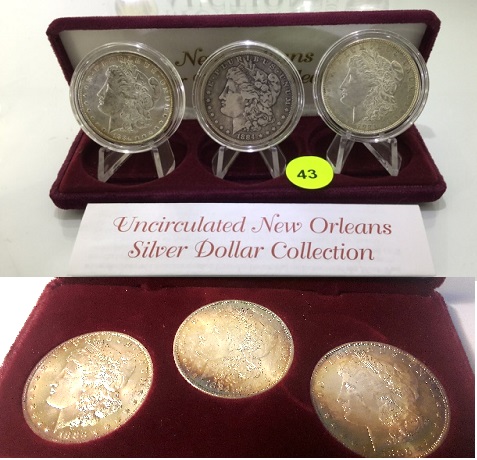
The Littleton Coin Company has sold these sets for many years, stored in a velvet case that usually results in rich toning. In the photo above, the bottom set is original; the top set, swapped out. Resist any such set that lacks toning, is my advice if you’re looking for original coins.
To read the complete article, see:
The great coin swap: Get wise about online buys
(http://news.coinupdate.com/the-great-coin-swap-get-wise-about-online-buys/)

NUMISMATIC NUGGETS: FEBRUARY 18, 2018
1910 Matte Proof Lincoln Cent
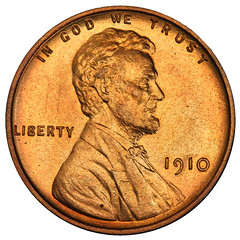
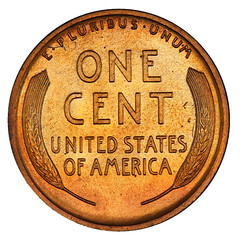
Finest known 1910 matte proof penny and we believe better than the one other at this level that traded 41,125 7/17 LA. The strike and level of red could not be finer. The color and originality is unmatched by any matte proof Lincolns I have seen on the market. CU = 45,000. Suitable for the finest Lincoln set or as a great put away coin.
To read the complete issue, see:
In the Loupe February 13, 2018 (https://mailchi.mp/bc416b47caff/pre-ana-part-one-1444633?e=aee4d54c5d)
1915-S Panama-Pacific $2.50 Gold
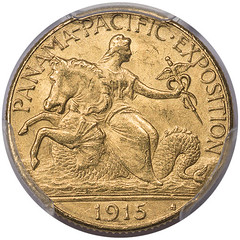
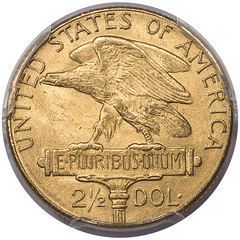
To read the complete issue, see:
In the Loupe February 13, 2018 (https://mailchi.mp/bc416b47caff/pre-ana-part-one-1444633?e=aee4d54c5d)
1928 Mussolini 2 Lira Token
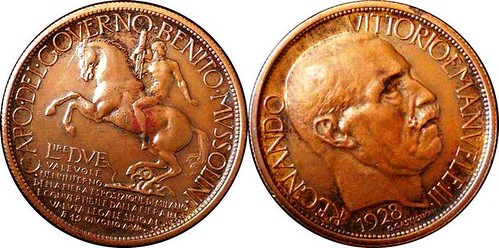
Mussolini Government:
Kingdom of Italy, Vittorio Emanuele III, 2 lire token 1928 Johnson.
To read the complete lot description, see:
Kingdom of Italy - 1928 - ‘Fiera di Milano’ (Milan
Fair) Vittorio Emanuele III - 2 lira Buono (token) (https://auction.catawiki.com/kavels/16787053-kingdom-of-italy-1928-fiera-di-milano-milan-fair-vittorio-emanuele-iii-2-lira-buono-token)
THE BOOK BAZARRE
FINEST LIBERTY SEATED DOLLAR COLLECTION SOLD INTACT
David Lawrence Rare Coins issued this press release about the intact sale of a fabulous collection of U.S. Half Dollars, led by the legendary 1870-S rarity. -Editor
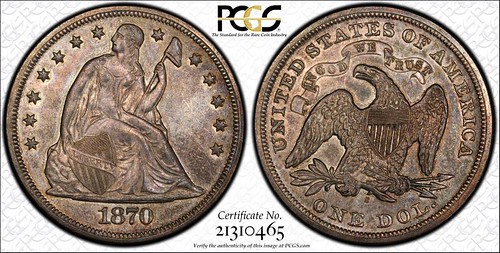
David Lawrence Rare Coins of Virginia Beach has purchased one of the most impressive sets of U.S. coins that has ever been assembled. The collection, pieced together by mega-collector Bruce Morelan via Legend Numismatics, was set to be auctioned through Legend Auctions in May. However, in advance of the auction announcement, the set was acquired intact by David Lawrence Rare Coins on behalf of DLRC’s partner, Dell Loy Hansen.
For Bruce, the thrill of the hunt had ended since there were no better coins to include. He had enjoyed the set for many years, even selling it intact to a coin investment fund in 2008. He was later able to purchase it once again before improving it with several additional spectacular specimens. In the end, Morelan felt it was time to pass the coins on for other collectors to enjoy. However, when rumor suggested that a "world class" collection was to be auctioned, John Brush reached out to Legend to inquire about the coins. When they found out that the legendary set was being offered, DLRC and Dell Loy Hansen jumped on the opportunity and the negotiations with Laura Sperber of Legend Numismatics took only a few hours.
“This is simply a group of coins that should not exist. The quality of each of the Seated Dollars is absolutely impeccable, and every single coin was hand-picked for not only condition, but ultimate quality,” says John Brush, President of David Lawrence. “When we found out that the set was going to become available, we acted quickly as we view this as one of the few collections that simply should not be broken apart if at all possible. The sum of all its pieces are so much greater than the individuals, and we wanted to do our part to try to keep it intact. When I notified Mr. Hansen about it, he thought that it was an excellent opportunity and one that we should pursue immediately.”
“If a collector was to own only this set, he or she would own by far one of the greatest collections ever assembled,” remarked Laura Sperber. “There is not a single coin that is anything less than the absolute best in quality and eye appeal by at least a full grade or more, in many cases. With what Dell Loy is trying to accomplish, this monster Hall of Fame set is a perfect fit for his collection. I am thrilled to see it placed with him instead of being broken up. I know he cherishes it and will allow it to be displayed to treat the current and future collecting public. I am sad to see the set go as I have enjoyed exclusively building it for fifteen years. It was certainly a highlight of my career.”
The collection not only houses the finest known pieces of many of the individual dates, but each piece is CAC-certified for quality as well. Of particular interest are the 1851 and 1852 Seated Dollars. The 1851 is graded by PCGS as MS65 and was once part of the legendary Norweb Collection. The 1852 is similarly graded by PCGS and is simply an amazing example of this key date. With coins from the legendary Garrett, Share, Childs, Fairfield, Stack, Hayes, Amon Carter, and Knoxville Collections, this set was put together over many years by some of the most discerning eyes in the coin industry. In fact, many acquisitions were made as part of larger collections to add a single coin to the set. A group that can never be duplicated, this is truly one of the Hall of Fame collections.
DLRC and Dell Loy Hansen are looking forward to exhibiting the collection in the near future, but for now it is available for viewing as a PCGS Registry Set at D.L. Hansen Liberty Seated Dollar Set.
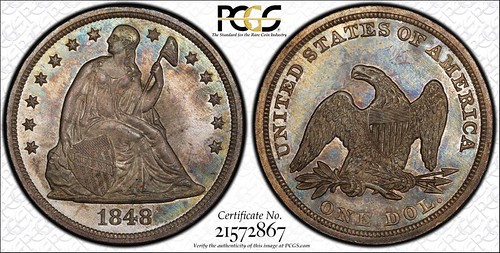
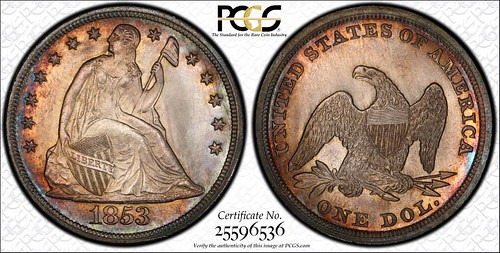
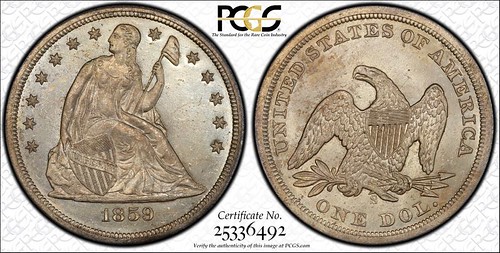
To view the complete set, see:
D. L. Hansen Liberty Seated
Dollars (1840-1873) (https://www.pcgs.com/SetRegistry/dollars/liberty-seated-dollars-major-sets/liberty-seated-dollars-basic-set-circulation-strikes-1840-1873/alltimeset/152934)
For more information on David Lawrence Rare Coins, see: https://www.davidlawrence.com/
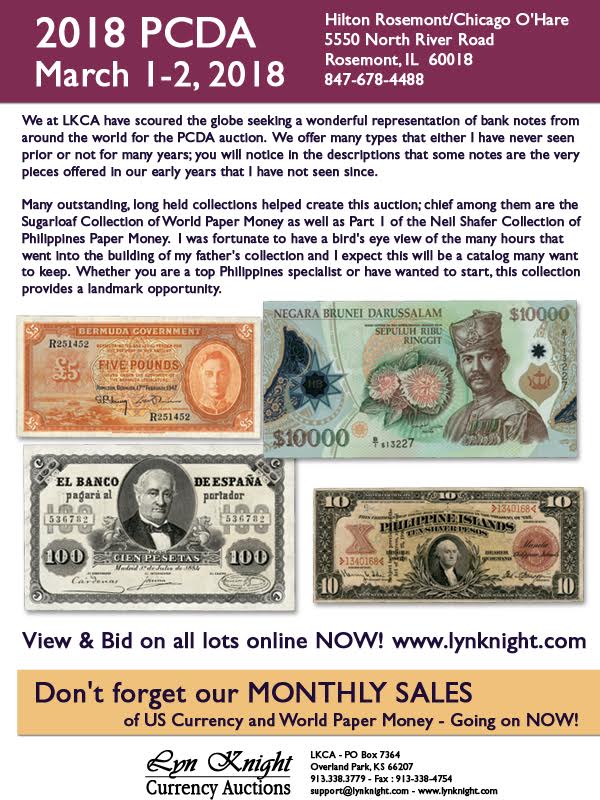
BOWERS/WHITE CHINESE COPPER COIN SELECTIONS
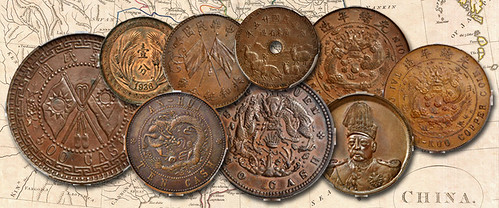
In the study of numismatics one can learn a lifetime’s worth of knowledge in a relatively short period of time, given the chance and right circumstances. It is not every day that one gets the opportunity to catalog an extensive collection of any sort. The opportunities are even fewer to catalog a cabinet of the magnitude and specialization assembled over decades by Q. David Bowers/R.B. White. Included in this monumental offering by Stack’s Bowers and Ponterio are many highly sought after rarities and very interesting pieces that have been off the open market for 50 years or longer. It was a pleasure and a great honor to catalog such a collection, one that encompasses so much and yet is very focused.
Coins produced from copper and its alloys have a deeply rooted history in Chinese numismatics. The Spring and Autumn period (ca. 770-476 B.C.E) saw the introduction of the first metal “coins,” these in the shape of knives and spades. In later periods the more familiar square-hole Cash were produced. In the late 19th century, the Kwangtung mint, the first mechanized mint of China, was set up by the Heatons of Birmingham, England. It became the largest mint in the world, surpassing facilities in London, Vienna, Berlin, Osaka, and Philadelphia.
The first issues from the Kwangtung mint had far reaching implications, as they would set the standard design for China’s new machine-struck coinage. In time, many modern mints were set up all over China, resulting in a wide variety of styles and characteristics specific to individual regions. Though nearly all were based on the first issues from the Kwangtung mint, each has its own distinctions.
The amount of material that was acquired by Q. David Bowers / R.B. White and then painstakingly attributed could be overwhelming if taken in all at once. To help better understand the depth and breadth of this astonishing collection, we will describe selections from the late-Qing to the early Republic to highlight the numismatic treasures it contains.
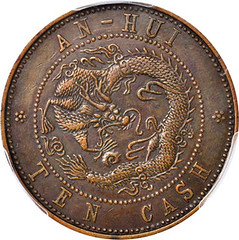
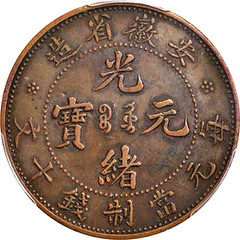
We start with this Anhwei “Flying Dragon” 10 Cash undated (ca. 1902-06) with the English spelling of the province name blundered, reading “AN-HUI”. It is a type and variety that rarely appears on today’s market.
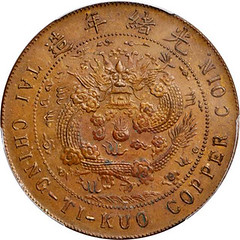
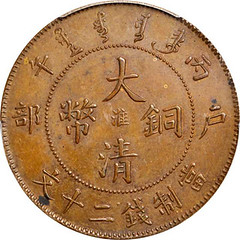
Next is a Kiangsu-Chingkiang Pattern 20 cash (CD 1906) that is one of only two known and the only example in private hands. The other is in the Shanghai museum. Since the Chingkiang mint was initially set up to produce 10 cash size coins they needed additional equipment to make this denomination. After a small number were struck it was discovered that this new minting equipment lacked sufficient power to produce these larger size copper coins. They were never put into full production and the equipment was eventually disassembled and sent to the Nanjing mint.
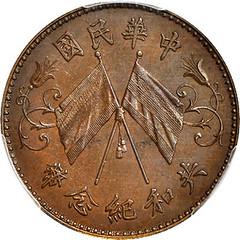
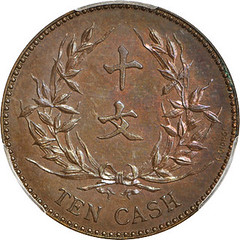
The prolific die engraver and head of the Tientsin mint from 1910-20, Luigi Giorgi, designed and presented a number of patterns, each featuring his signature “L. Giorgi” or “L.G.” These included what would become the standard Yuan Shih-kai 1914 Dollars and their subsidiaries, including Cash coinage.
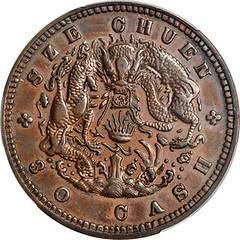
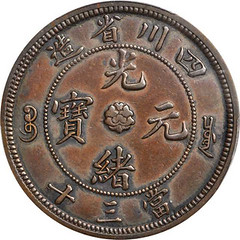
Perhaps one of the most legendary and certainly among the most recognizable issues is the Szechuan Pattern 30 Cash undated (1904). There are two major types, the “Water Dragon” and the “Flying Dragon”, struck in two different metals all of which are extremely rare. It is believed that for all types combined only about 12 examples are known, with about half of those permanently impounded in institutions.
Rick Ponterio writes:
The Q. David Bowers auction of Chinese copper coins will take place on Monday, April 2nd in Hong Kong at the Mira Hotel. On Tuesday, April 3rd we will be auctioning Chinese coin coins, Ancient through modern from other consignors. On Wednesday, April 4th, we will be auctioning Chinese and world paper money as well as world coins.
Kyle adds:
The Q. David Bowers/R.B. White collection will be a standalone catalog. There are some pretty great foreign coins in the Hong Kong sales, including three British Triple Unites and a mint state William and Mary Five Guineas.
To read the complete article, see:
Cataloging the Q. David Bowers / R.B. White Collection of Chinese Copper Coins
(http://www.stacksbowers.com/News/Pages/Blogs.aspx?ArticleID=2860)

WAYNE'S NUMISMATIC DIARY: FEBRUARY 18, 2018
Tuesday February 13, 2018 was the meeting night of my Northern Virginia numismatic social group Nummis Nova. Our host was Steve Bishop and he'd made reservations for Cyclone Anaya’s Mexican Kitchen in Fairfax, VA.
I was the first to arrive and parked myself at the bar. Arriving shortly afterward was Joe Esposito. We ordered drinks and I munched on a basket of warm chips. We talked about our upcoming dinner at the Baltimore Whitman Coin Expo in March, and the publication of Joe's new book in April. Dinner in Camelot about the evening in April 1962 when President and Mrs. Kennedy hosted 49 Nobel Prize winners and other American intellectuals at the White House.
It wasn't long before other members began to arrive, including Dave Schenkman, Eric Schena, Wayne Herndon, Robert Hoppensteadt and Steve himself. Dave brought along his set of the Carolina TAMS Journal, a publication of the Carolina Token and Medal Society. Eric offered to help me research it before offering it to the Newman Numismatic Portal. The group is defunct, but is the copyright orphaned, or held by another organization?
We took seats at our table and were soon joined by Roger Burdette, Mike Packard and Tom Kays. I had nothing for display this time, but as usual a number of great numismatic items came around the table.
Colonials
Mike Packard had a nice group of colonial coppers, new purchases from a recent online auction.
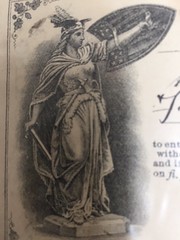 19th Century Fiscal Paper Steel Engravings
19th Century Fiscal Paper Steel Engravings
Tom Kays writes:
The most interesting items I brought were 19th century steel engravings on fiscal paper from a Pennsylvania collection. These are on notes on indebtedness from the 1870s - 1895.
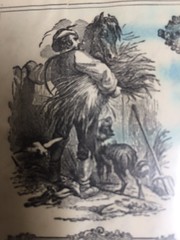
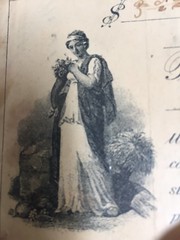
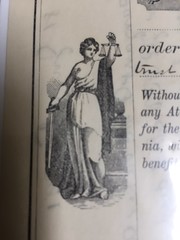
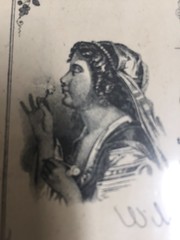
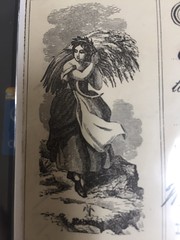
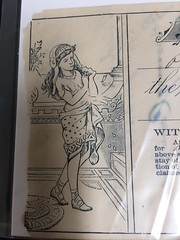
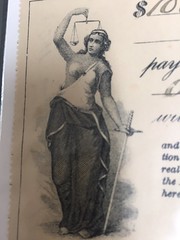
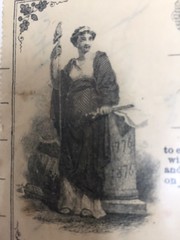
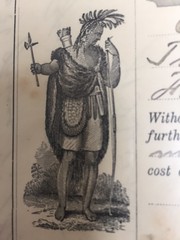
Postal Savings System Certificates
Eric Schena writes:
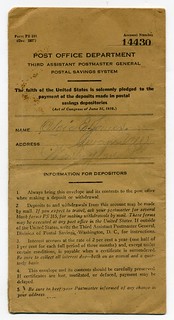 I brought my collections of Postal Savings System certificates of deposit from the Mid Atlantic - all three of them. The Postal Savings System was a form of postal banking established by
Act of Congress in 1910. As the USPS states, it was “aimed to get money out of hiding, attract the savings of immigrants accustomed to saving at Post Offices in their native countries, provide safe
depositories for people who had lost confidence in banks, and furnish more convenient depositories for working people.”
I brought my collections of Postal Savings System certificates of deposit from the Mid Atlantic - all three of them. The Postal Savings System was a form of postal banking established by
Act of Congress in 1910. As the USPS states, it was “aimed to get money out of hiding, attract the savings of immigrants accustomed to saving at Post Offices in their native countries, provide safe
depositories for people who had lost confidence in banks, and furnish more convenient depositories for working people.”
The deposits started at $1 and were limited at first to $500 then later to $2,500 and paid a nominal 2% interest rate. The system ceased in 1967 and redemption ceased as of 1985 with any unclaimed deposits held in trust indefinitely by the Treasury. They issued a number of certificates of deposit ranging up to $500 in denomination and were issued all over the US.
I have been looking for examples from our region and have not seen all that many. The DC specimen in my collection has the original envelope, as well. Dave Schenkman pointed me to one issued in Quantico a week or two back and I snagged it and brought it to pass around. I think these are a very interesting segment of our financial history and hope that more research on the certificates themselves is being made.
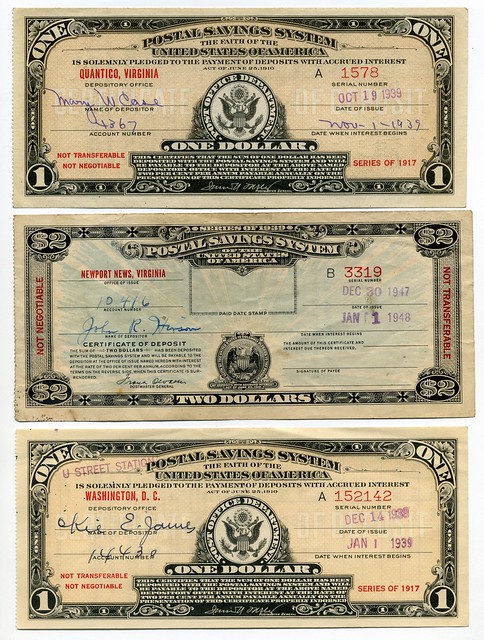
I had been familiar with these but never collected them. I agree with Eric that they are important financial history artifacts. Thanks for the images!
Token and Medal
Past Token and Medal Society (TAMS) President Dave Schenkman appropriately had a token and medal on display. He kindly supplied these images.
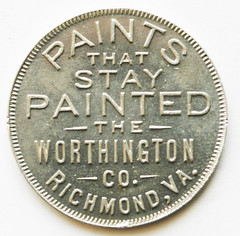
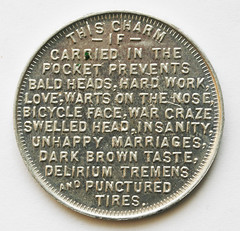
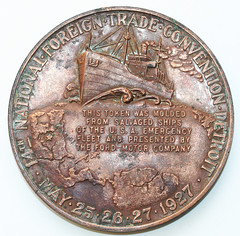
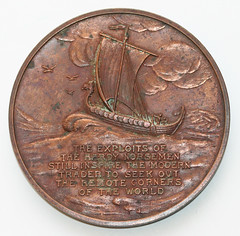
Dave adds:
The token is aluminum, 30mm; that cure-all reverse is found on quite a few merchant tokens. The medal is copper, 70mm.
I can report that there were no nose warts, bicycle face, insanity, delirium tremens, punctured tires or other maladies reported at the meeting. Thanks, Dave!
Toned Dollars
Steve Bishop is a regular buyer of nicely toned dollars, and he had several on display. here are a couple.
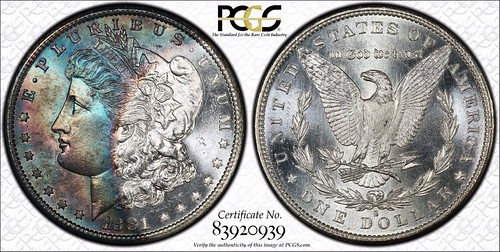
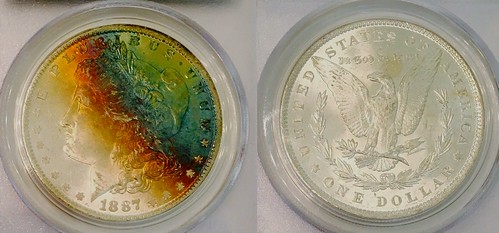
Buick Dollar
Here's the packaging for the Buick Dollar Steve shared with us a couple weeks ago,

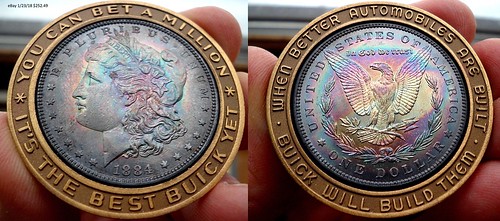
To read the earlier E-Sylum article, see:
QUERY: BUICK, GENERAL MOTORS ENCASED DOLLARS (http://www.coinbooks.org/v21/esylum_v21n05a20.html)
Tidy House Dollar
One of Steve's displays was one of the promotional Tidy House dollars along with all of its original packaging. At my request he made scans of the associated flyer in addition to these pictures.
Coincidentally, just that morning I had added an article on the Tidy house dollars by Michael Bugeja to The E-Sylum - see it elsewhere in this issue.
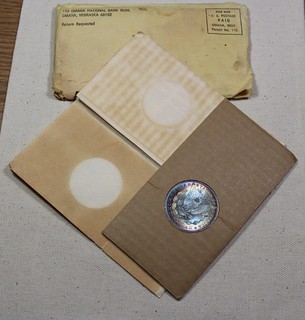
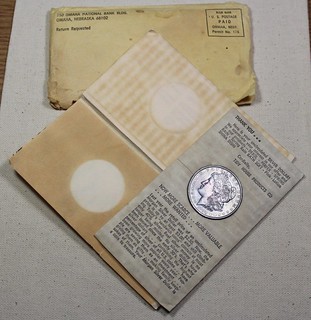
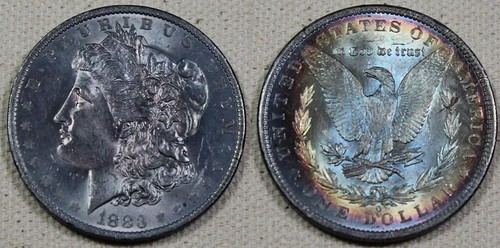
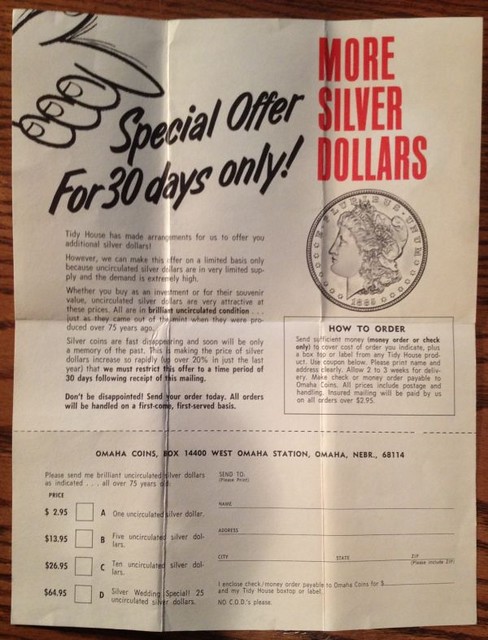
Handwriting Recognition
My neighbor at the dinner table was Roger Burdette, and we had a nice conversation about his transcription project. With a help of a number of volunteer workers Roger is building transcriptions of
many handwritten numismatic source documents, primarily U.S. Mint-related record from the National Archives. Eventually these will be added to the Newman Numismatic Portal, where the hand-generated
text can be located in searches.
Roger is experimenting with software solutions to the problem of creating these transcriptions. While the optical character recognition (OCR) problem has been largely solved for uniform printed or typewritten text, the recognition of handwriting has largely eluded capture. If a tool for assisting with the transcription task were to come along, it would be a boon for numismatic research.
'Til Next Time
It was a small group and we broke up early, around 8:30pm. Although there were some mixups with our orders, the food was generally quite good and all of us had a nice time. What a great way to spend
an evening - surrounded by great numismatics, numismatists, and food and drink.

A LIST OF COIN EVENT WEB SITES
While we prioritize sites in English, other languages are welcome if the sites contain good information. Here's a list of major coin events around the U.S. and the world. Are any BIG ones missing? -Editor
BANS Congress
COINEX
ANA Summer Seminar
World Paper Money Fair
Paper Money Fair - Maastricht
International Paper Money Show
Numismata Vienna
Hong Kong Coin Show
Midland Coin Fair
London Coin Fair
Bloomsbury Coin Fair
World Money Fair
Numismata Berlin
Numismata Frankfurt
Numismata Munich
Tokyo International Coin Convention
Porto International Numismatic Fair
International Coin Conference and Exhibition
Singapore International Coin Fair
Chicago Coin Expo
FUN Show
New York International Numismatic Convention
Central States Numismatic Society Convention
Whitman Expo
Long Beach Expo
World's Fair of Money
National Money Show
To read some earlier articles, see:
A LIST OF COIN BLOG WEB SITES (http://www.coinbooks.org/v20/esylum_v20n30a28.html)
A LIST OF COIN FORUM WEB SITES (http://www.coinbooks.org/v20/esylum_v20n31a14.html)
A LIST OF COIN DATABASE WEB SITES (http://www.coinbooks.org/v20/esylum_v20n37a11.html)
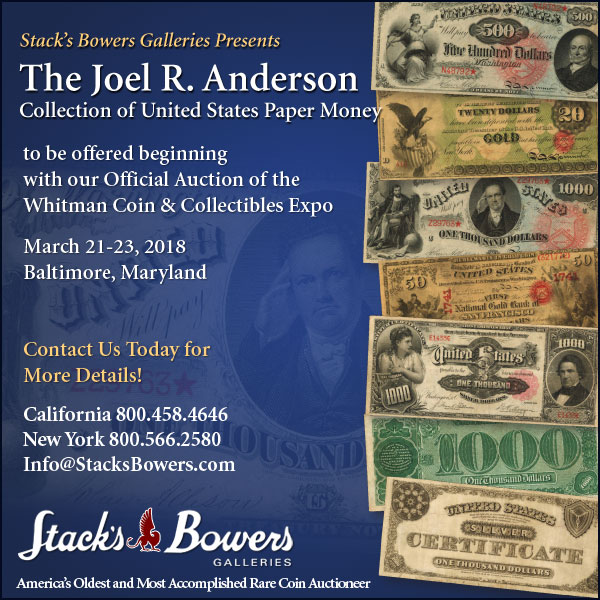
THE CONFEDERATE CATHOLIC REBEL CROWN

Auction 37 closes this coming Wednesday, February 21st. Make sure to place your bids in time! Allan wrote this article on one particularly noteworthy lot in the sale.
Plain, crude, uneven strike, rugged—why its appeal? What is its story? Of the five siege crowns issued in Ireland during the English Civil War, this piece is remarkable because of its religious connection. The 2006 sale of Lucien LaRiviere’s comprehensive Irish collection had examples of all five Irish siege crowns. I was able to buy four, all except this one type that sold for many times estimate. I was simply outbid.
These coins are very rare, and rarely offered. So, when I had the chance to buy this one, I was keen, and successful.
It is easy to focus on the Civil War in England and not think as much about its impact on Ireland. In Ireland, a chief tension was between Irish Catholics on one side and English and Scottish Protestants on the other. Who would rule Ireland? The enmity between Protestants and Catholics burst open during the reign of Mary Tudor. It was in full bloom during the tempestuous reign of Charles I during the Civil War’s sturm und drang chaos and Catholic forces rose up.
Their crown with its elegantly simple cross design was issued for their use in the Civil War—wars always cost money. Their forces were ultimately defeated by Cromwell but we still have this rare remnant of their history.
For me, an unextinguishable joy of making numismatics my profession has been handling coins with exceptional appeal -- magnificent history and often an amazing work of art from another era.
I may “own” it for a brief time but while I can handle many wonderful coins I cannot afford to keep them for more than a relatively short period of time. But then, all of us who love coins know well that our ownership is a brief interlude in their journey through time.
I have a personal list of my hundred favorite British coins. This is on it.
Allan Davisson
February 2018
To browse Davissons' Auction 37, see:
https://davcoin.com/sale/Printed%20Auction%2037
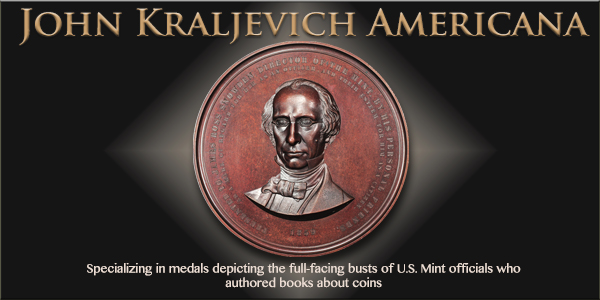
AUSTRALIAN MINT SUED BY CANADA OVER PATENT
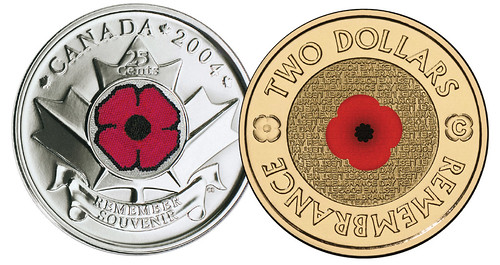
The Royal Canadian Mint (RCM) is suing its Australian equivalent, the Royal Australian Mint (RAM), following an alleged patent infringement dating back to 2012.
Documents filed by the RCM in Australia’s federal court on Dec. 22 allege the RAM used a patented printing method relating to how the latter mint printed red poppies on its commemorative Remembrance Day coins. The RCM is now demanding 500,000 $2 coins struck by the RAM – with a total value of $2 million – be turned over or destroyed. The RCM is also requesting the RAM be restrained from further patent infringement or from “making, selling, supplying or otherwise disposing of, using or keeping the infringing coins.” They also want Australian officials to admit their wrongdoing and turn over or destroy all promotional materials related to the infringing coins. Lastly, the RCM is demanding the RAM surrender its profits from the infringement or pay damages.
“The Royal Canadian Mint has launched legal proceedings against the RAM for infringement of the Mint’s patent in Australia when RAM produced a colour printed version of the Australian $2 coin with a red poppy without first having obtained our consent to do so,” RCM media relations manager Alex Reeves told CCN.
“Despite the Mint’s ongoing efforts to resolve the matter since 2015, it has become necessary for us to institute infringement proceedings to protect and preserve our intellectual property rights.”
To read the complete article, see:
RCM sues Australian Mint over patent infringement
(https://canadiancoinnews.com/rcm-sues-australian-mint-patent-infringement/)
NEW ZEALAND MaNUKA HONEY COIN
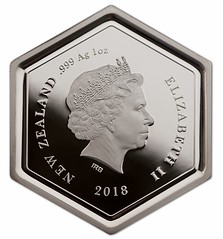
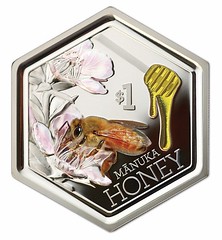
The Reserve Bank of New Zealand have unveiled (13th February) their second collector coin which focuses on the country’s lucrative honey industry. Following on the huge success of the Reserve Bank’s release of their first honey bee coin last year, a second coin is to be issued which features the golden nectar from the manuka honey bee and its extraordinary product.
The collector’s coin is produced by the B.H. Mayer’s Mint GmbH at their facilities in Bavaria, Germany, and is designed by Jonathan Gray of the New Zealand Post. The hexagonal shape has been used again as it represents honey bees and the actual honeycombs they use for storage. Coloured resin is used to depict the rich, golden colour of manuka honey, and can be seen dripping from a wooden dipper. A digitally printed honey bee is perched on a whitish-pink manuka flower. Other engraving techniques give further depth to the coin’s detailed design.
The obverse side depicts HM Queen Elizabeth II, as designed by Ian Rank-Broadley. This effigy has been used on all circulation and many collector and commemorative coins of New Zealand since 1999.
To read the complete article, see:
New Zealand: Latest honeybee collector coin unveiled features manuka
honey (http://world.mintnewsblog.com/2018/02/new-zealand-latest-honeybee-collector-coin-unveiled-features-manuka-honey/)

AUSTRALIA ISSUES NEW $50 BANKNOTE DESIGN
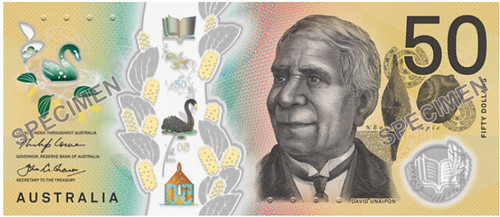
The Reserve Bank has today revealed the design of the new $50 banknote. As with the existing banknote, the new $50 features portraits of Aboriginal writer and inventor David Unaipon and the first female member of an Australian parliament, Edith Cowan. The new banknotes will be released into general circulation in October 2018.
Governor Philip Lowe said: ‘Improved security and ease of recognition underpin the design of the new $50 banknote. With the release of the $5 and $10 during the past two years, we are confident the Australian public are becoming familiar with the new banknote security features.’
These features include a top-to-bottom clear window that contains dynamic features such as a reversing number. There is also a patch with a rolling-colour effect and microprint featuring excerpts from David Unaipon's book and Edith Cowan's maiden parliamentary speech.
The Governor added: ‘David Unaipon and Edith Cowan were campaigners for social change and we are proud to continue featuring them on the $50 banknote. The new banknote provides the opportunity to tell more of the rich story behind these distinguished Australians.’
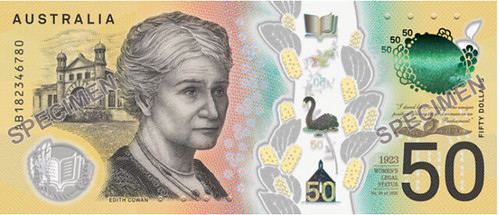
Their stories are told through a number of design elements, including shields from Unaipon's Ngarrindjeri nation and the practices of miwi and navel cord exchange about which Unaipon wrote. The banknote also includes a picture of the gumnut brooch Cowan had made to symbolise that entry into Parliament was a ‘hard nut to crack’ for women, and the King Edward Memorial Hospital, a women's and maternity hospital that she helped establish.
As with the $5 and $10, the new banknote includes representations of a wattle and a native bird. The $50 features Acacia humifusa and a Black Swan (Cygnus atratus), Unaipon's ngaitji, or totem, and the bird of Cowan's home state of Western Australia.
To read the complete article, see:
Next Generation of Banknotes: $50 Design Reveal (https://www.rba.gov.au/media-releases/2018/mr-18-03.html)

VENEZUELA CRAFTSMEN USE WORTHLESS BANKNOTES
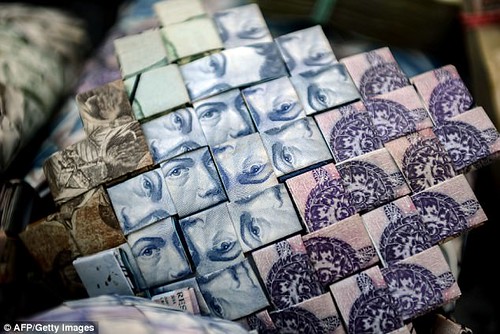
Street vendors in Venezuela are weaving baskets from banknotes after 13,000 per cent inflation rendered them practically worthless.
Inflation in the oil-rich Latin American nation has seen the economy spiral out of control, with its currency the Bolivar losing 87 per cent of its value against the euro.
Cash is worth so little there bank notes are often seen littered on the streets.
But street seller Wilmer Rojas has found a use for them.
The 25-year-old is selling origami-style handbags, purses, hats and baskets - all made out of money.
'You can use magazine paper or newspaper pulp, but currency notes are better because they are not worth anything, they are all the same size and you don't have to waste time cutting them.
'These things are no good for buying anything. At least I am putting them to good use rather than throwing them away.'
With two, five and 10 bolivar notes 'you can't even buy a piece of candy', he added.
Some of the woven creations sell for 300,000 bolivars - enough to buy a kilo of meat.
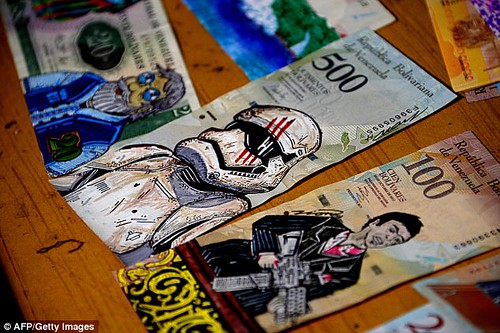
Jose Leon, a 26-year-old designer, draws the faces of Star Wars characters over the image of Simon Bolivar and other famous Venezuelans pictured on the notes.
Foreign customers pay him up to £14 ($20) for each piece of 'money art', which he said increases the note's value by nearly 5,000 per cent.
To read the complete article, see:
A basket case of a country! Venezuela's currency is worth so little that locals now
WEAVE goods out of it (http://www.dailymail.co.uk/news/article-5378769/Street-sellers-make-baskets-Venezuela-bank-notes.html)
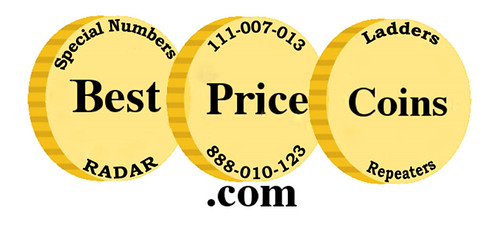
TRASH WORKERS DISCOVER BAG OF DAMAGED BANKNOTES
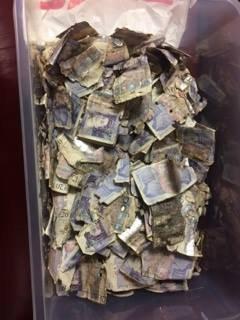 SKIP hire workers could be in for a jackpot win after stumbling across £7,000 in bank notes they found ripped up.
SKIP hire workers could be in for a jackpot win after stumbling across £7,000 in bank notes they found ripped up.
Quicker Skips employee Kevin Ball uncovered a black bag filled with thousands of pounds worth of damaged £20 notes at their site last month.
After handing the cash over police, officers failed to uncover enough evidence to track down the owner.
Now Kevin and his boss Mark Hanson, are waiting to find out if the Bank of England will reimburse them with the cash.
Mark Hanson, from Burnley, Lancs, said: “We managed to bring it all together and found that it was £7,000 instead of £2,000, which we originally thought.
“They were not in a great condition with some of them moth-eaten and cut in half. Also a lot of the notes were wet.
 “We will hopefully split some of the money among the workers and also give some to charity.
“We will hopefully split some of the money among the workers and also give some to charity.
Mark insisted that people had come forward trying to claim the loot, but Lancashire Police said there wasn't enough evidence to show they own the lump sum.
He said: “We had a few phone calls but they were lying."
To read the complete article, see:
HOPE, SKIP AND A LUMP Skip workers stumbled upon binliner filled with £20 notes worth £7k… and are now hoping
Bank of England give them the cash (https://www.thesun.co.uk/news/5593048/skip-workers-find-bag-7k-bank-of-england/)
IN OTHER NEWS: FEBRUARY 18, 2018
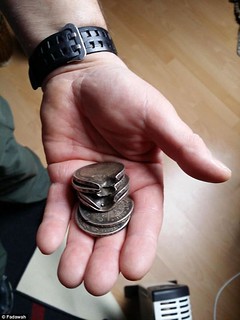 WWI Soldier's Life Saved By Coins
WWI Soldier's Life Saved By Coins
Money well spent: One man revealed his grandfather's life has been saved by the coins in his pocket when he was shot during the First World War.
Dick adds:
These look like silver Belgian 5 Francs.
To read the complete article, see:
That was close! From dodging a falling tree to being nibbled by a SHARK,
death-defying photographs show incredible near misses (http://www.dailymail.co.uk/femail/article-5400445/Images-people-narrowly-avoiding-horrifying-disasters.html)
FEATURED WEB SITE: NUMISMATICS INTERNATIONAL
This week's Featured Web Site is Numismatics International.Numismatics International (NI) was established in April 1964 and has members located worldwide. NI is the largest and most active numismatic organization in the world which excludes the sale, trade, discussion or display of coins and currency of the United States of America. This allows a focus to study and collect other countries and regions in the world.

? http://numis.org/

